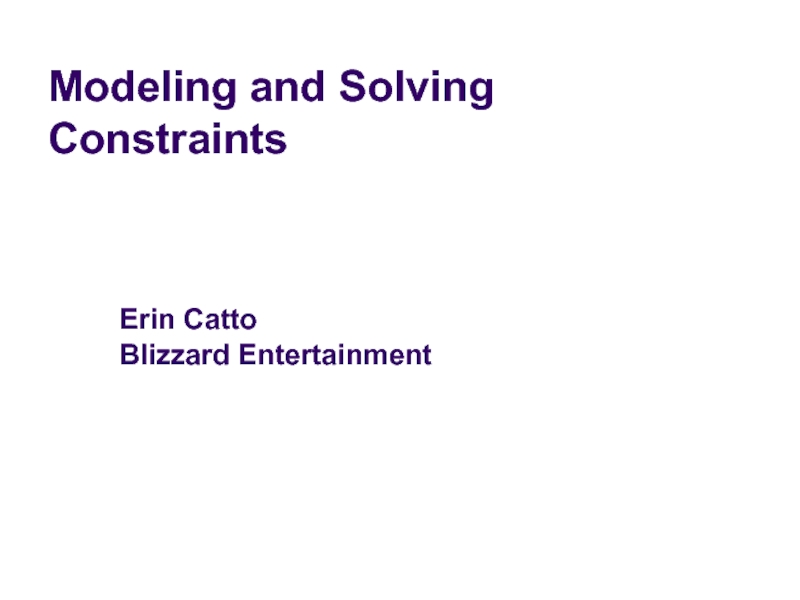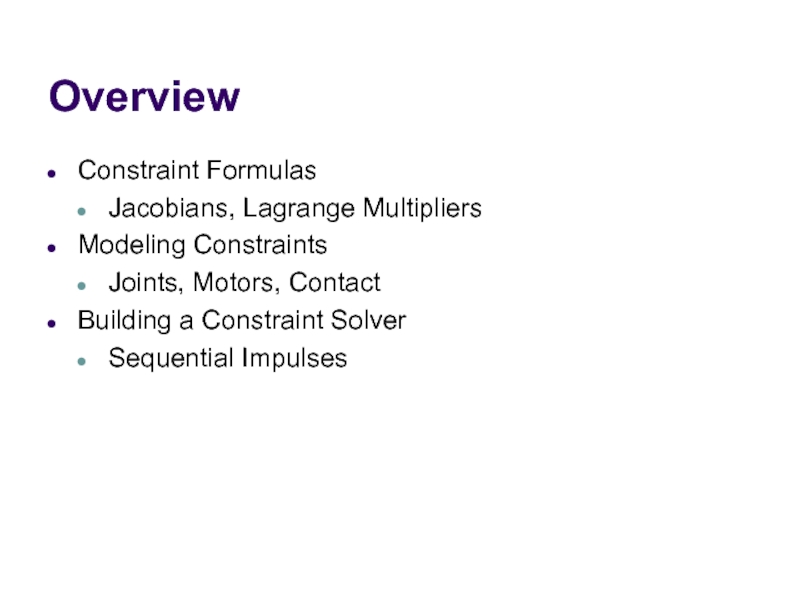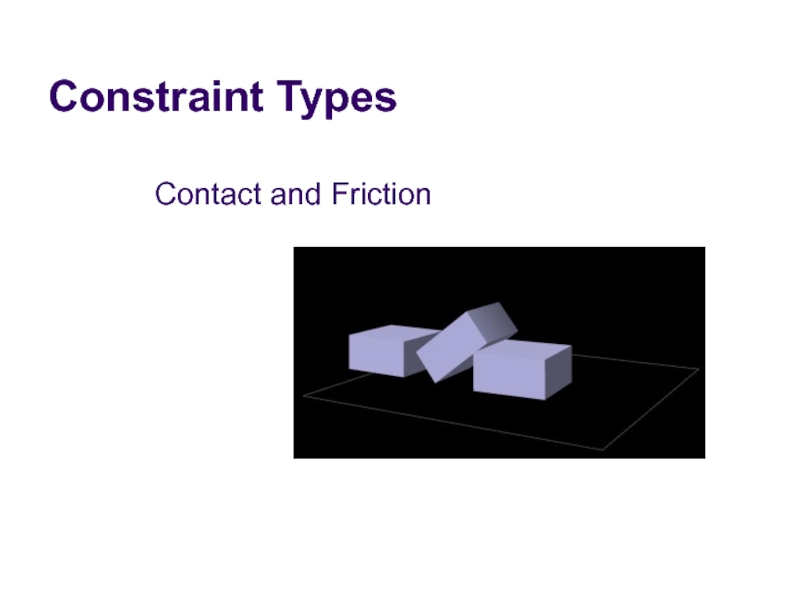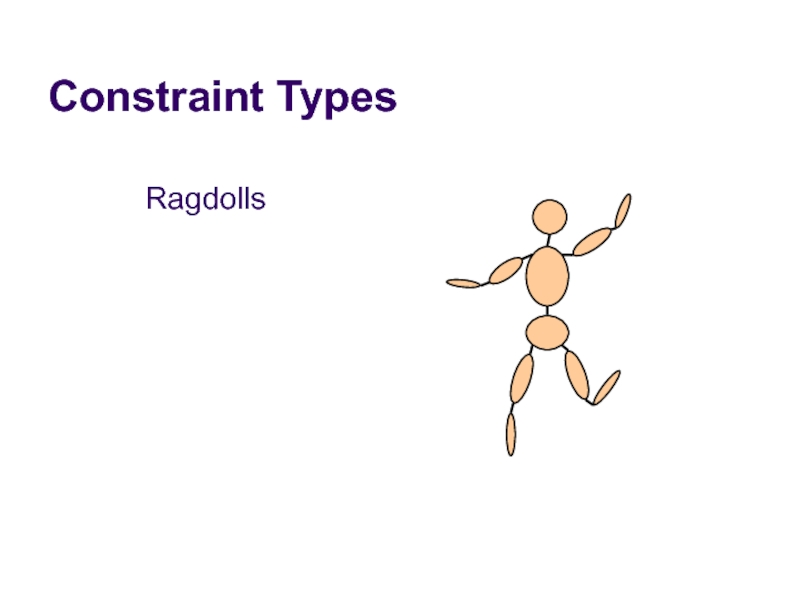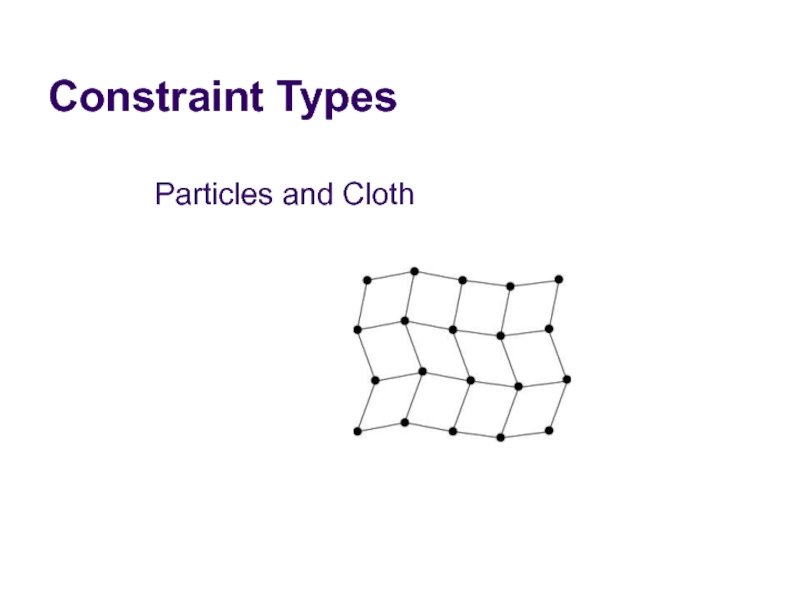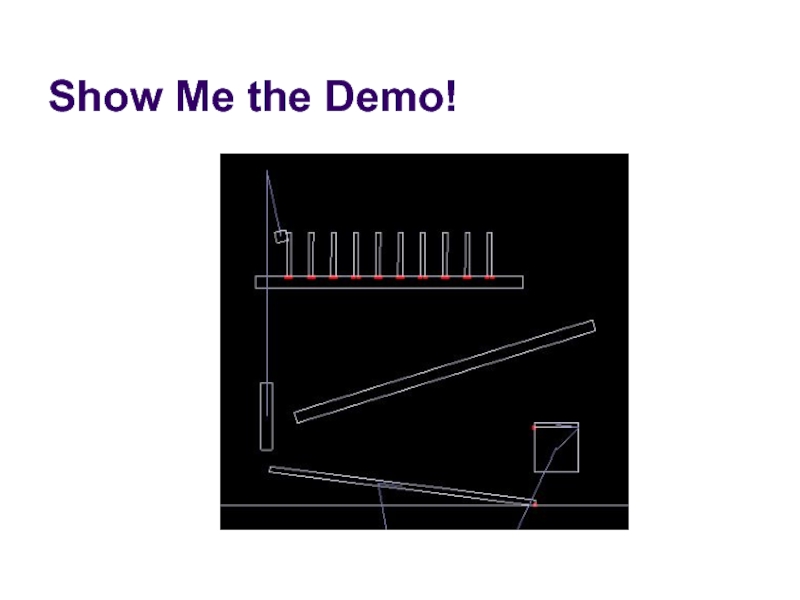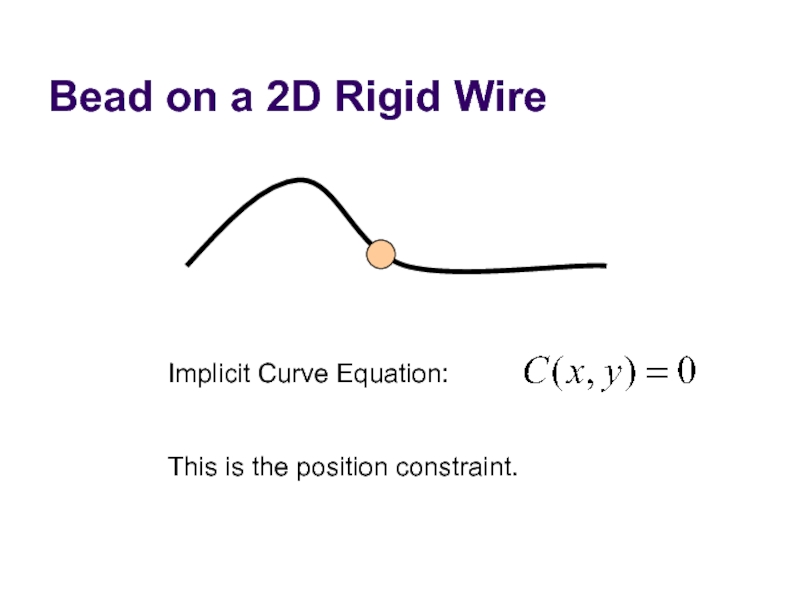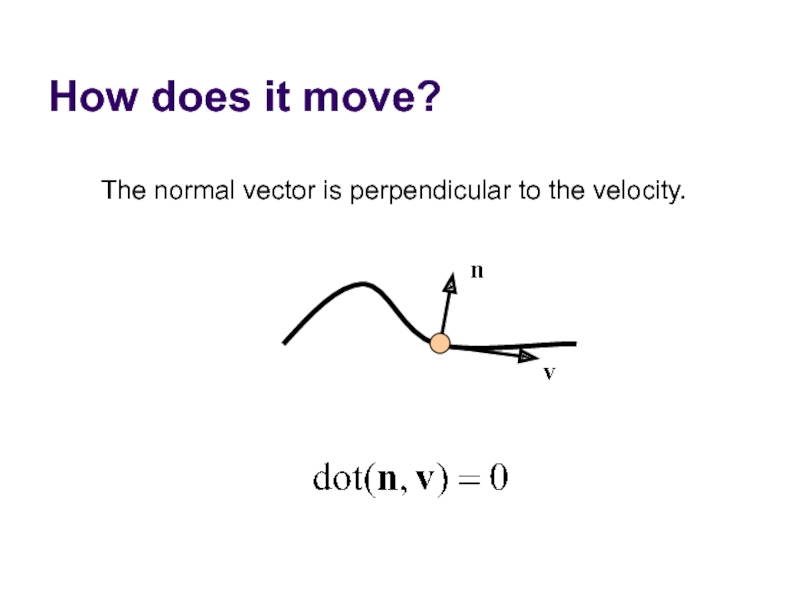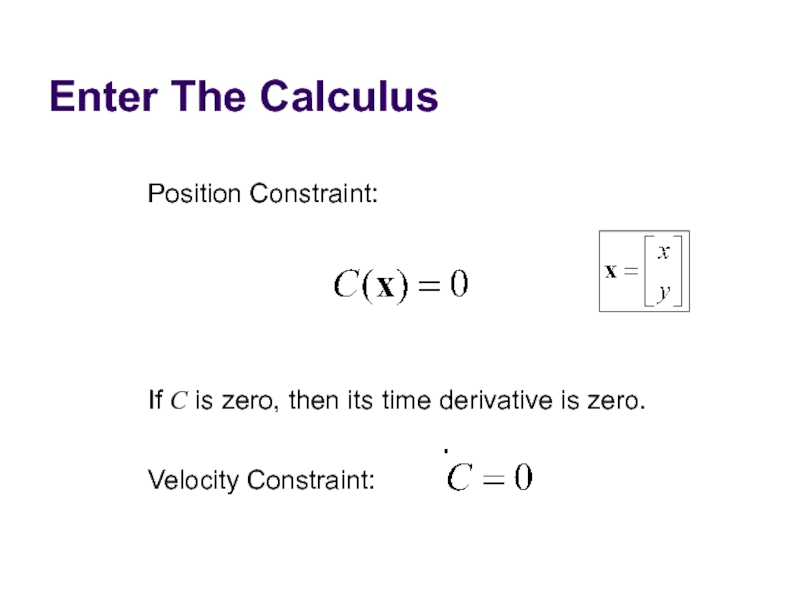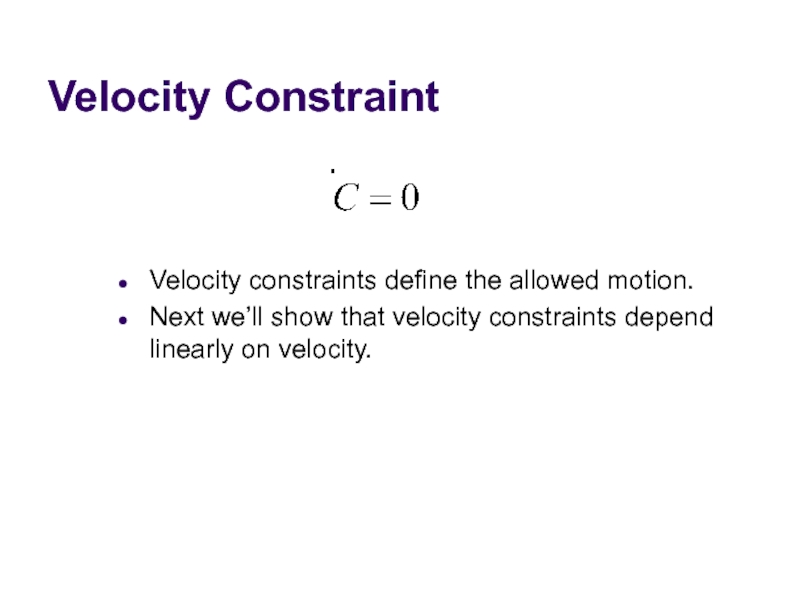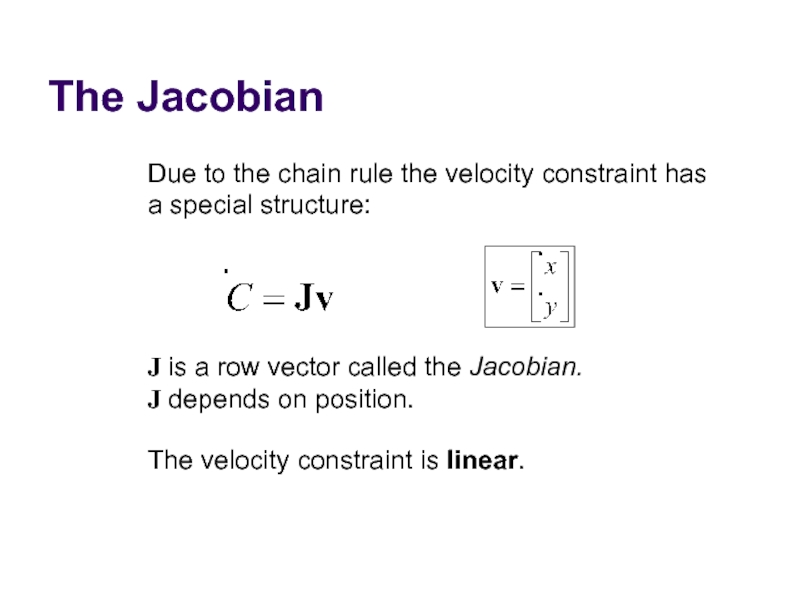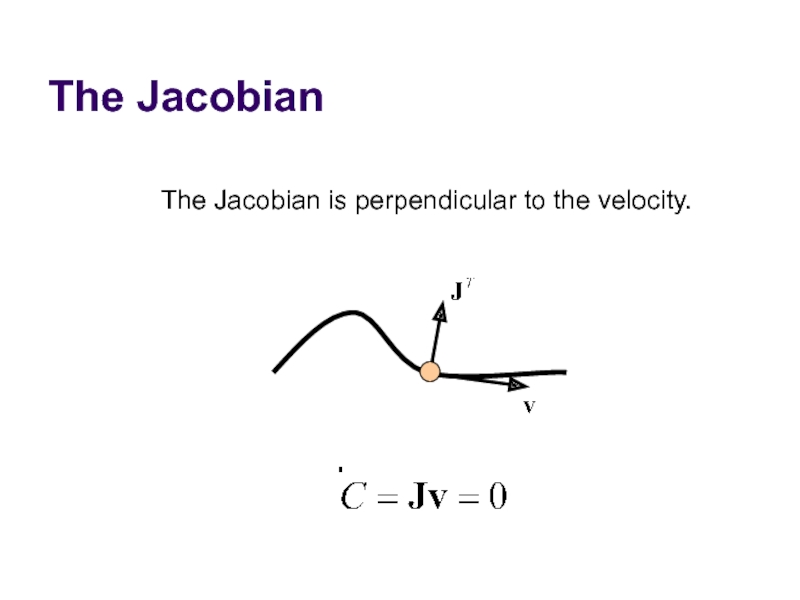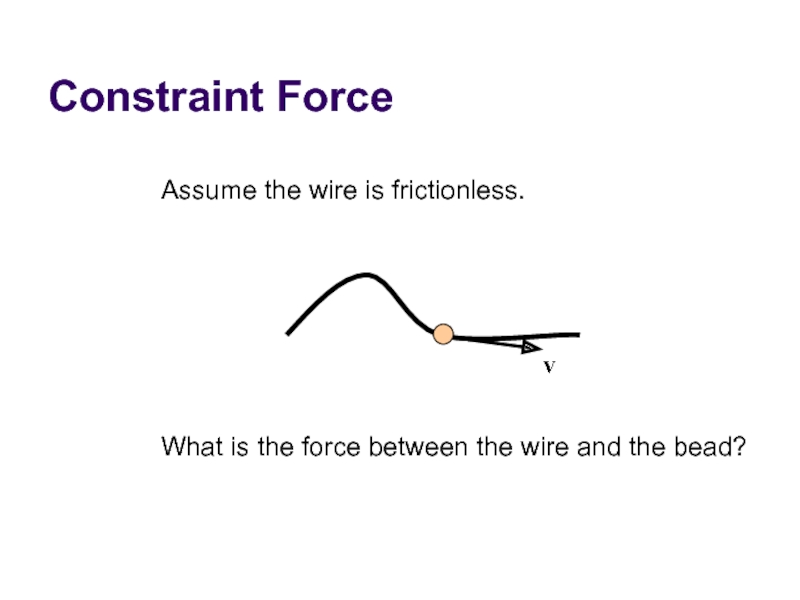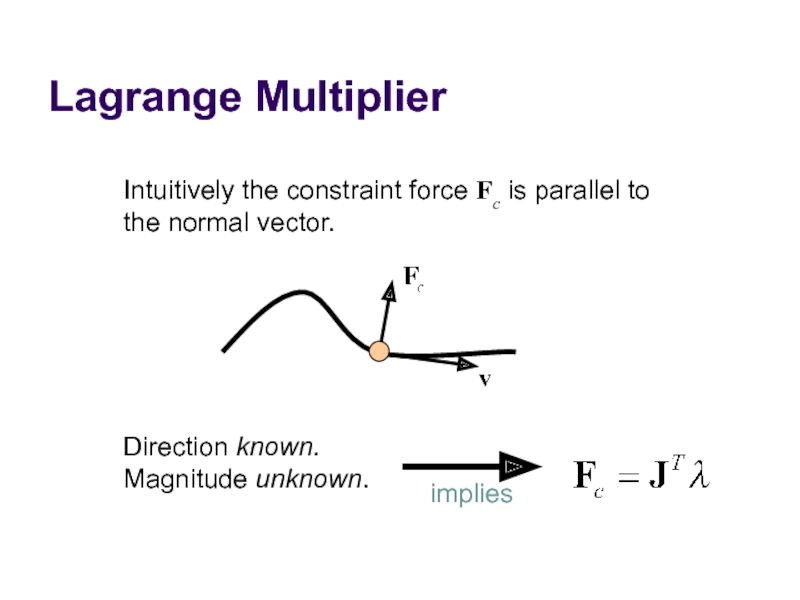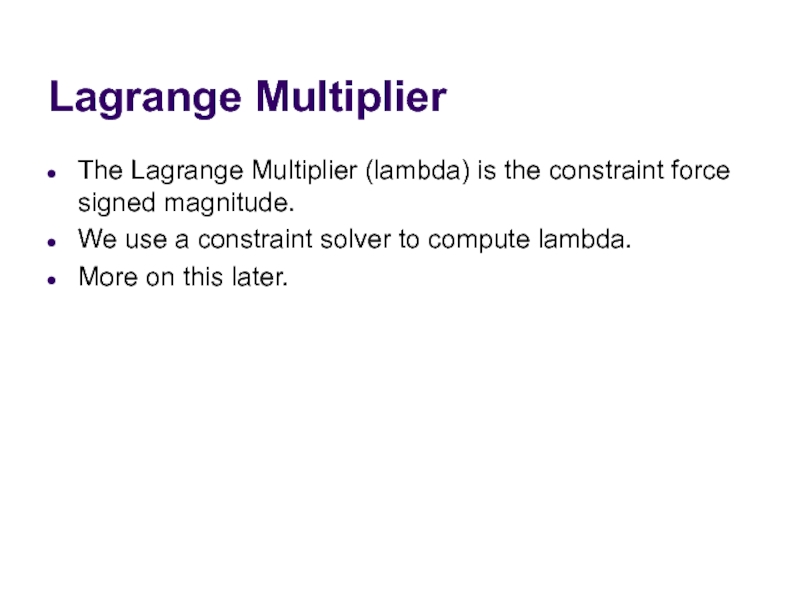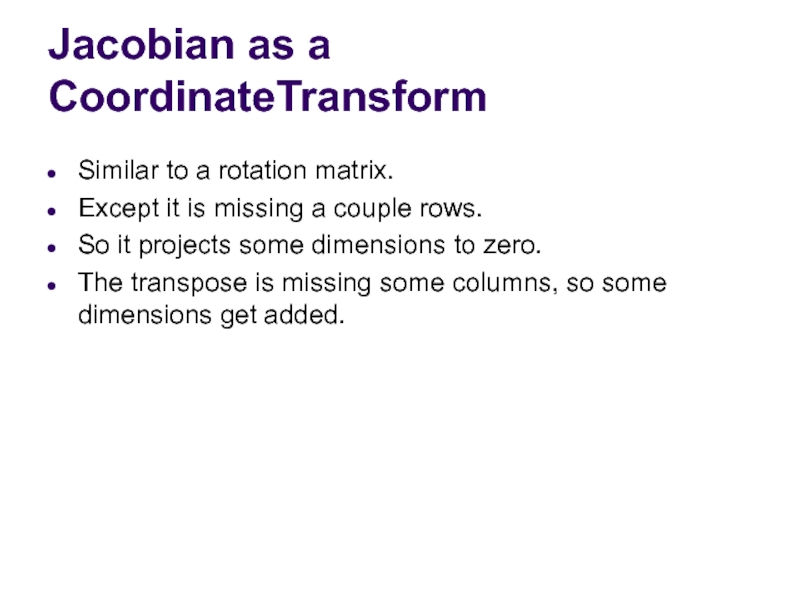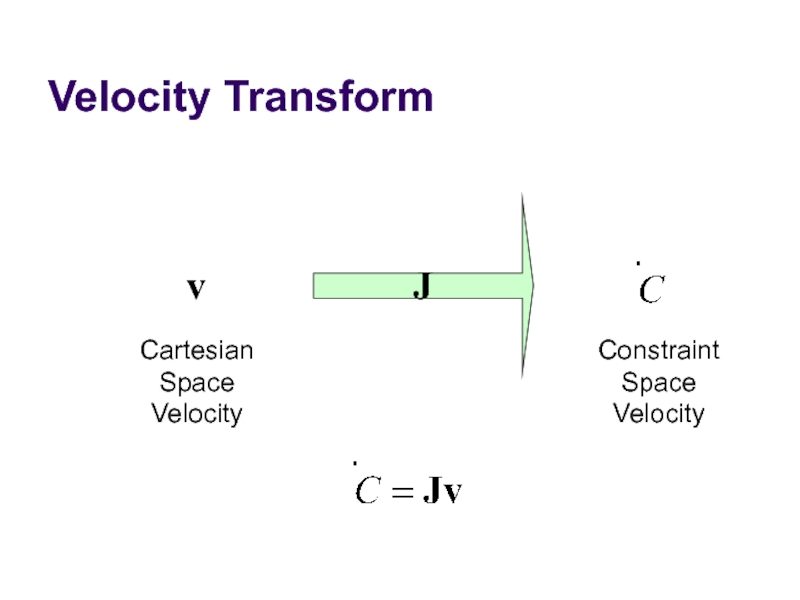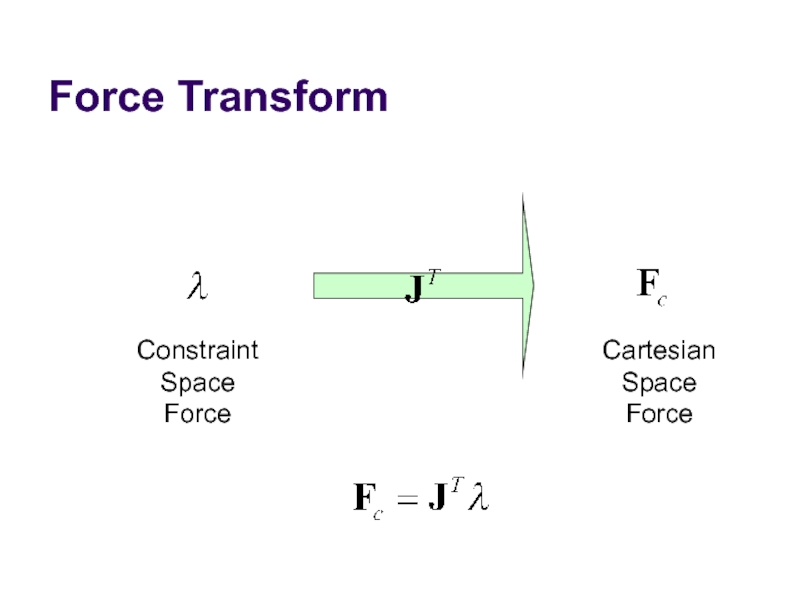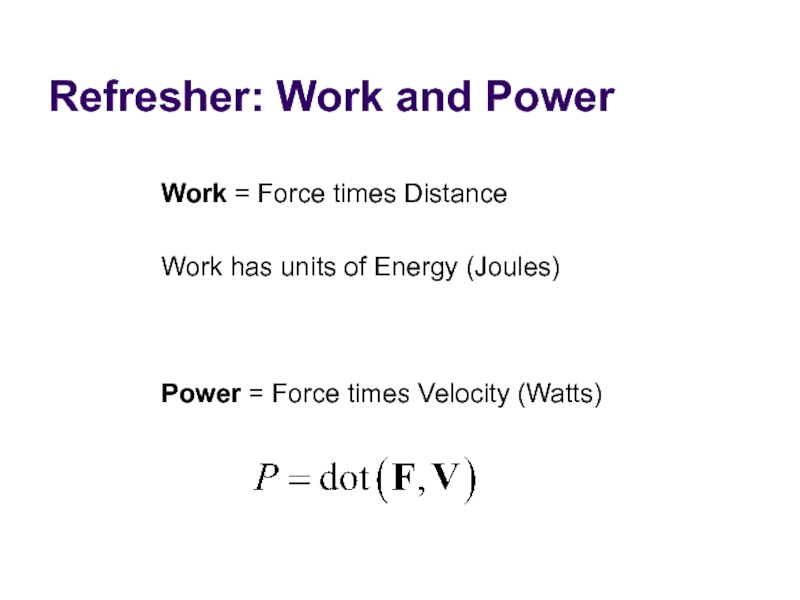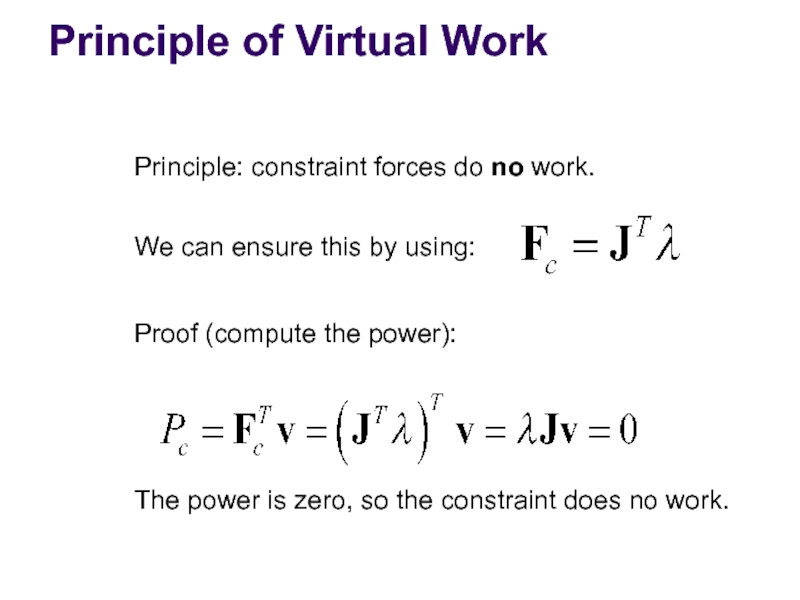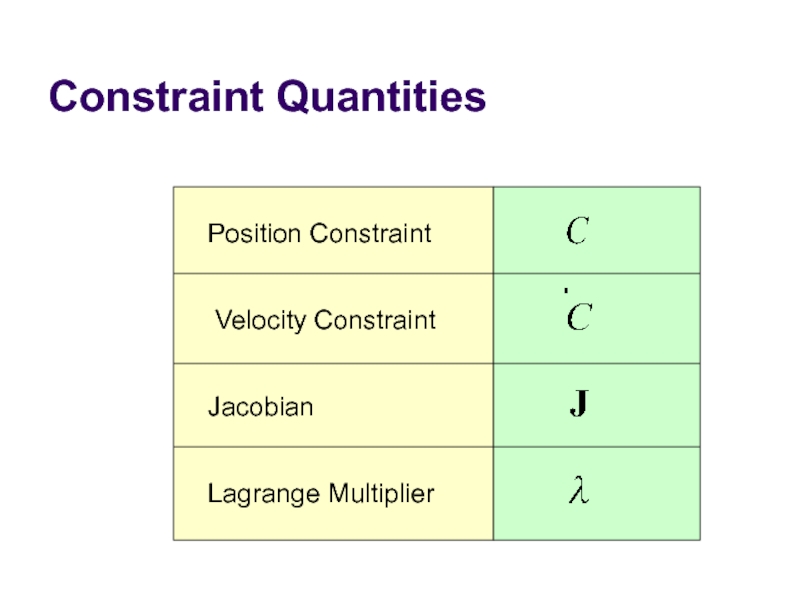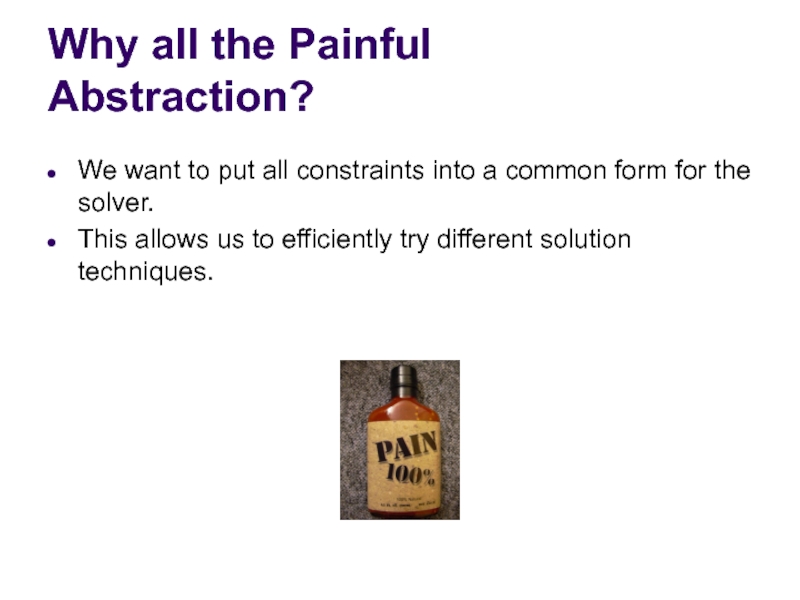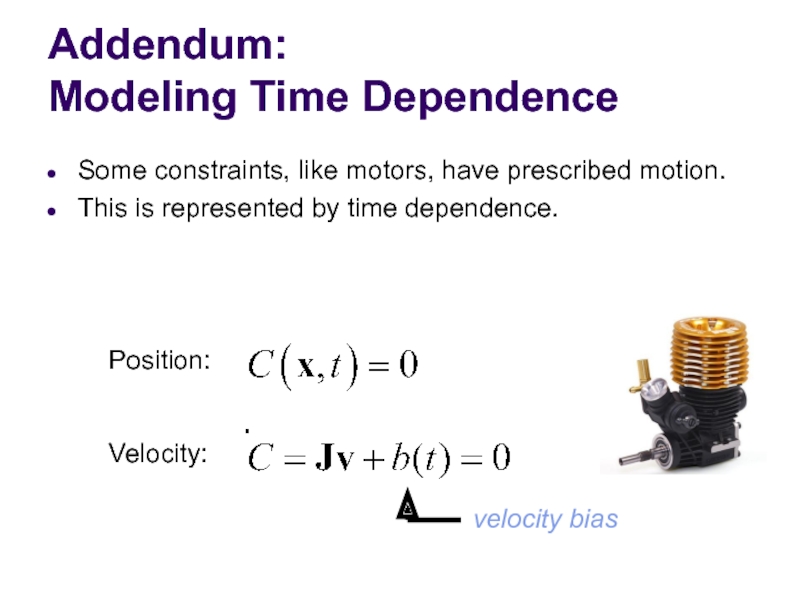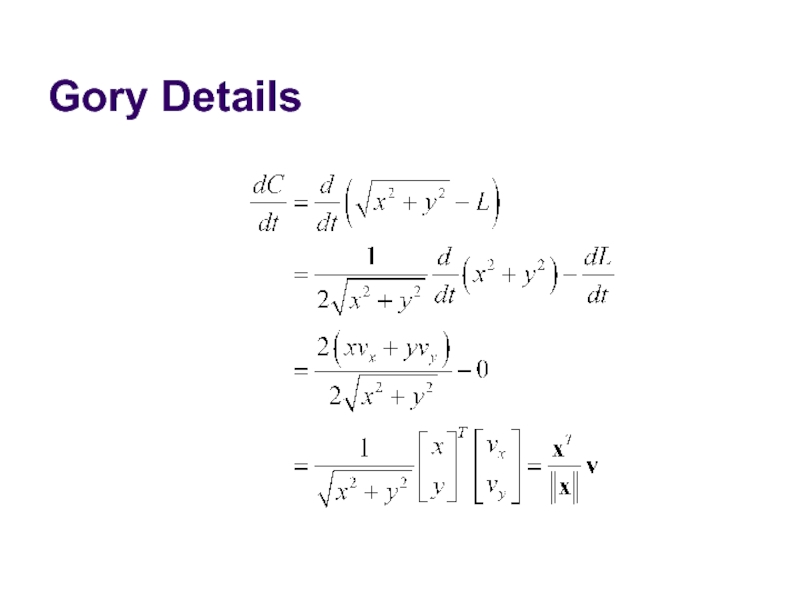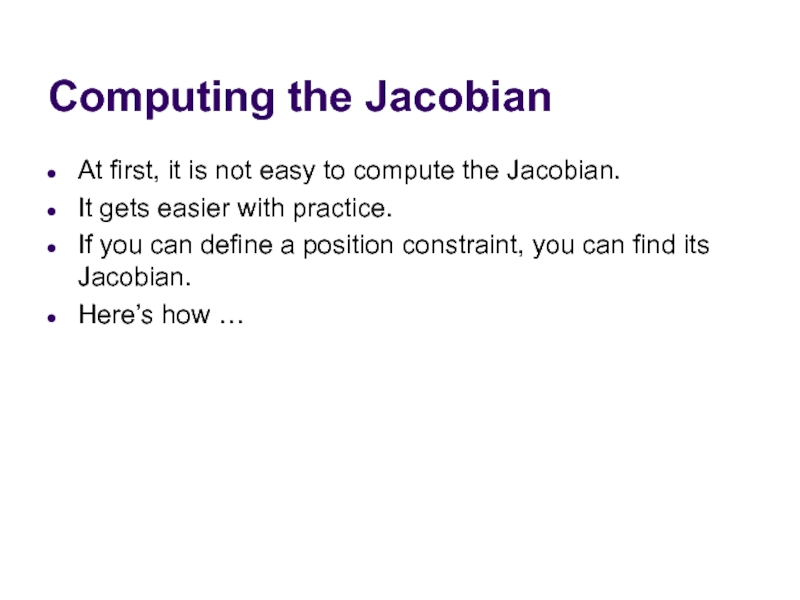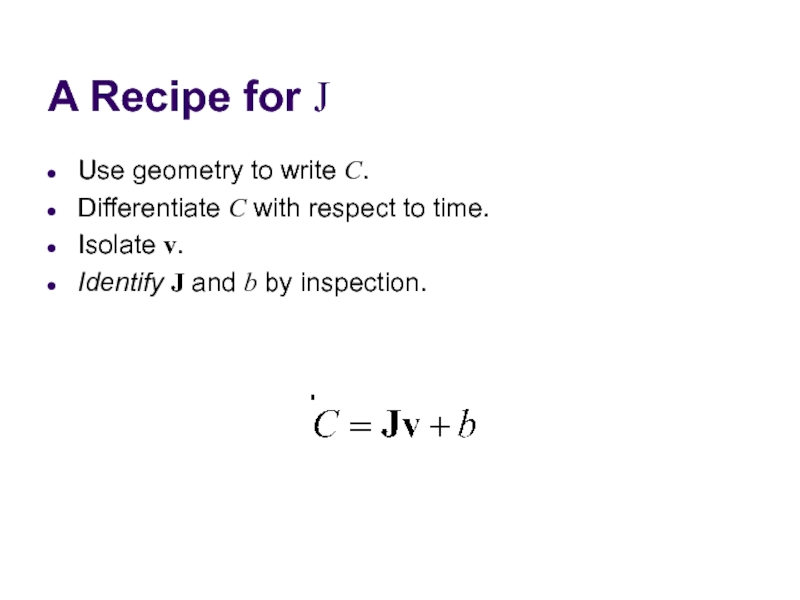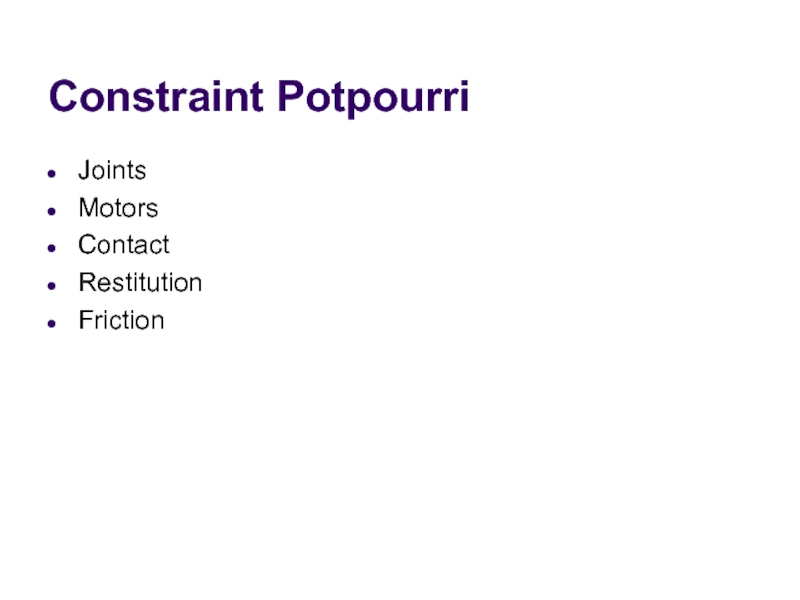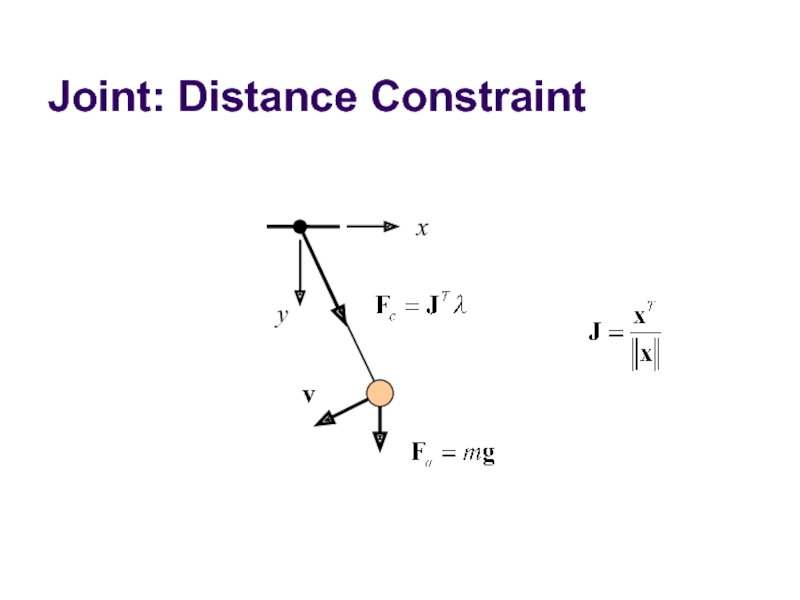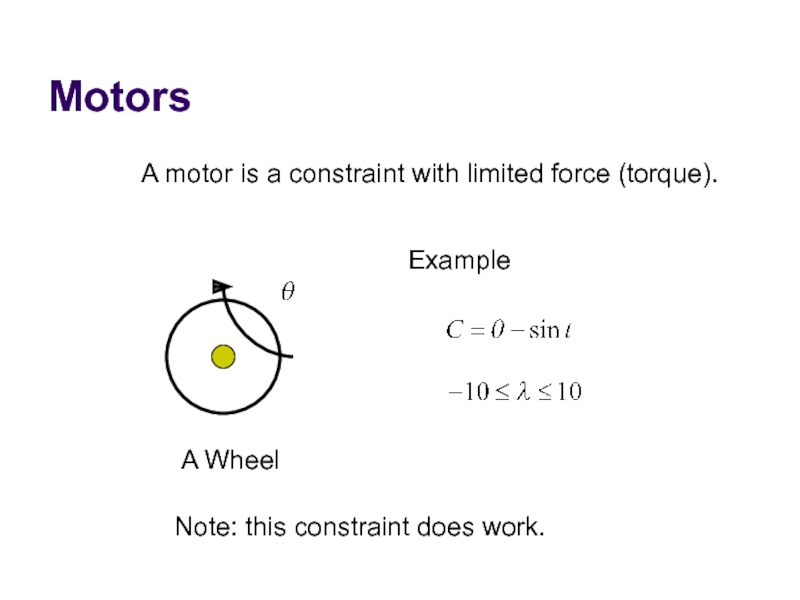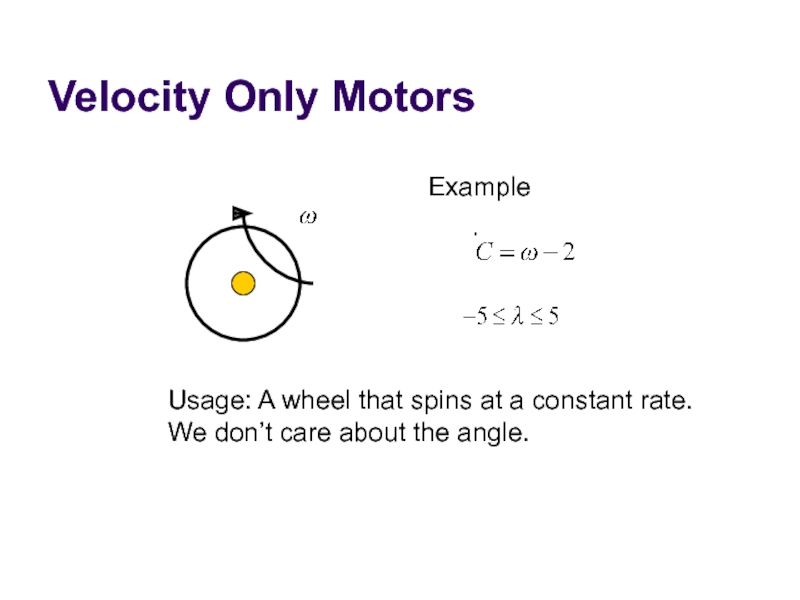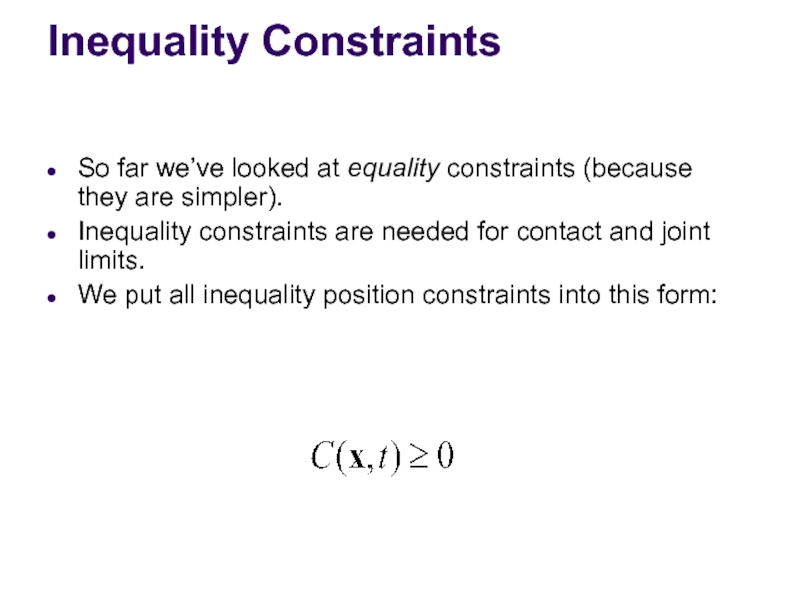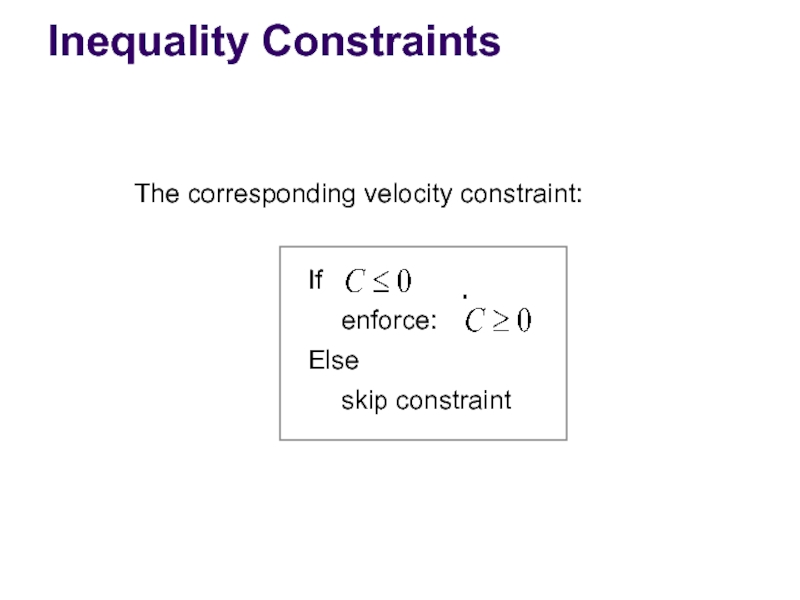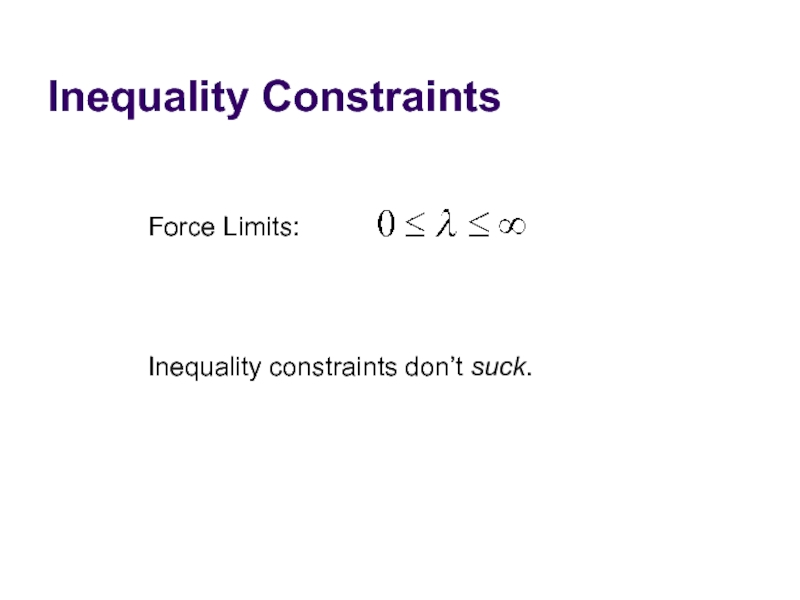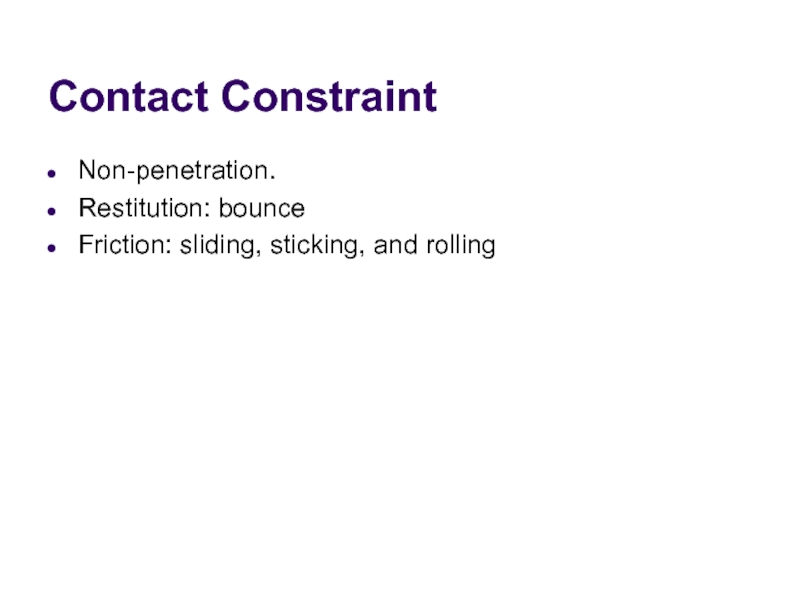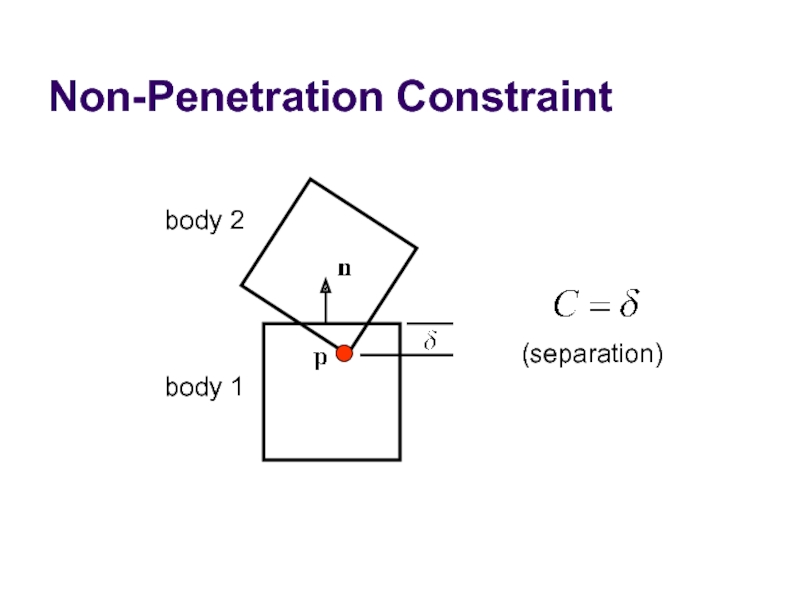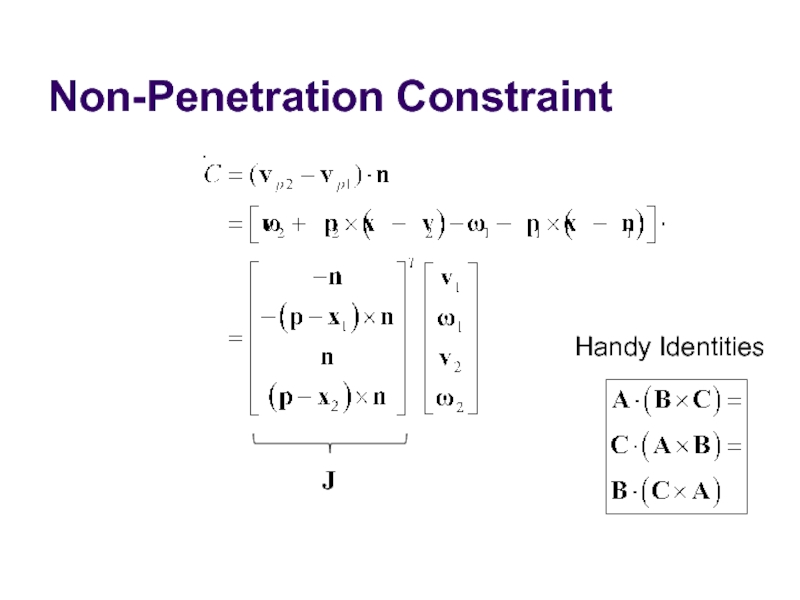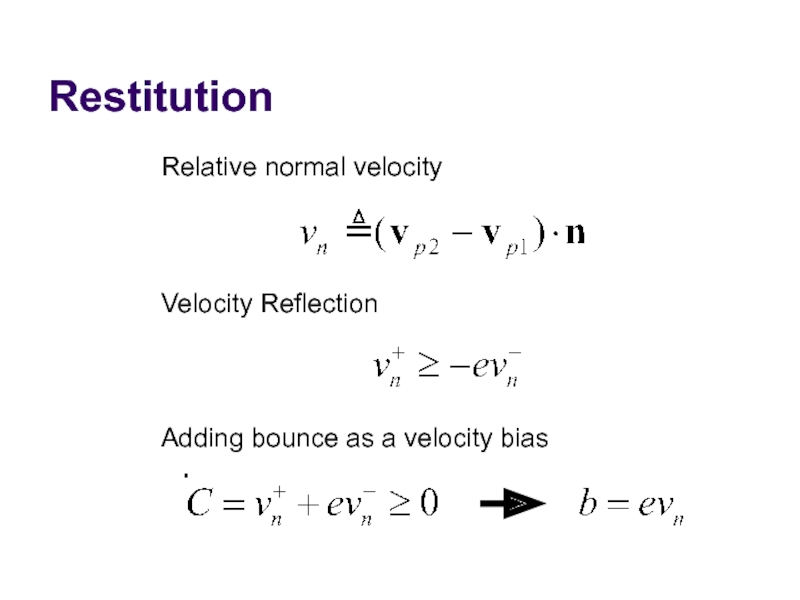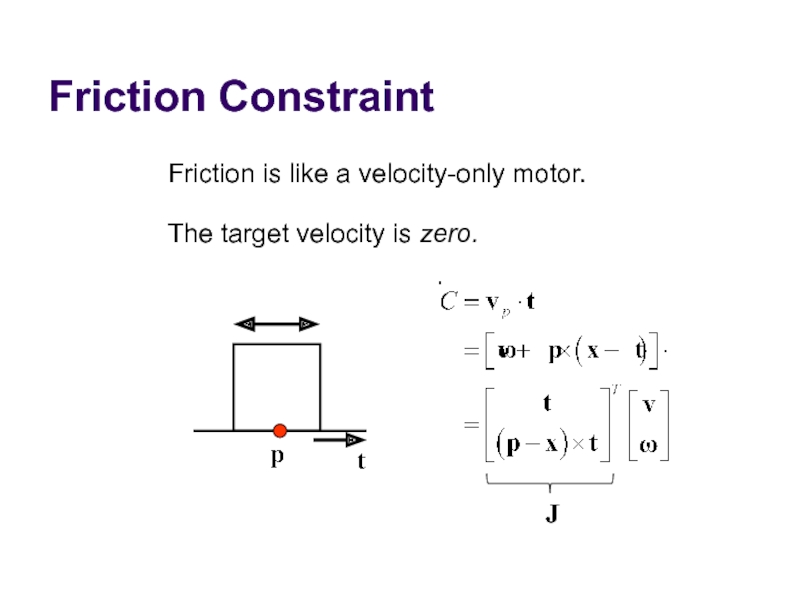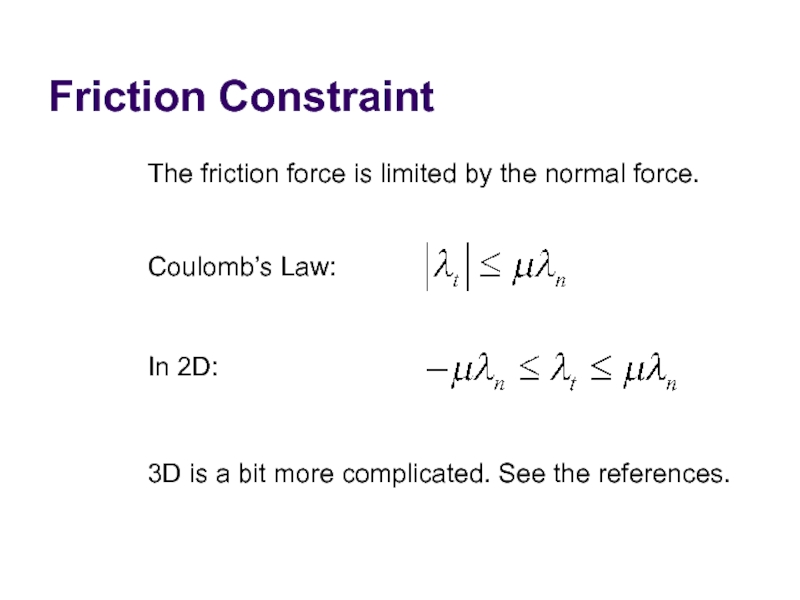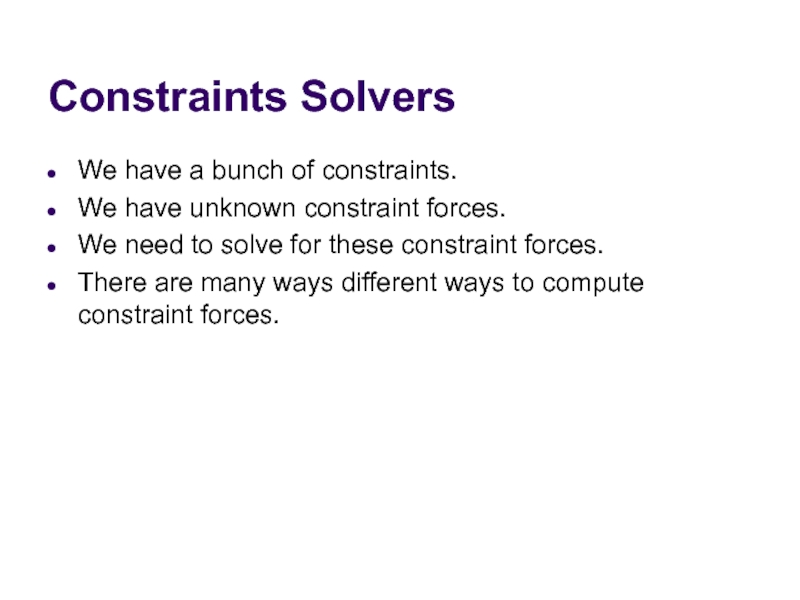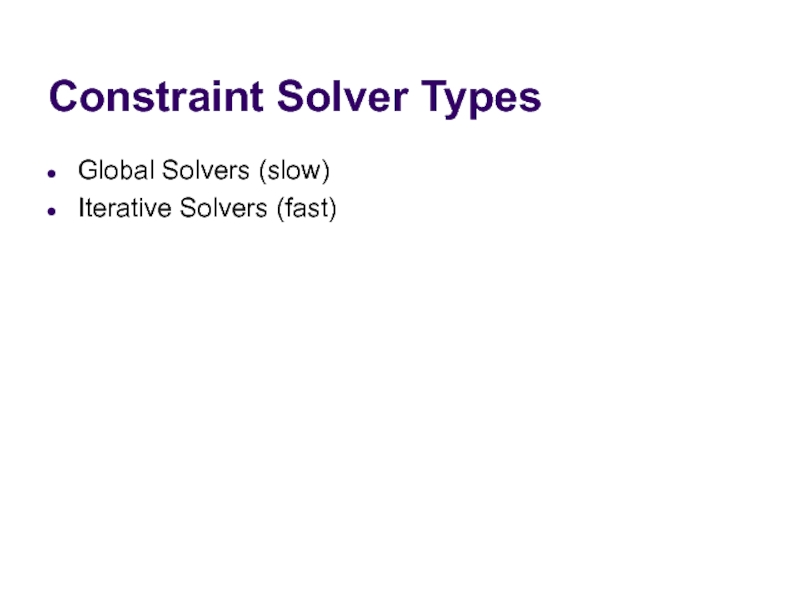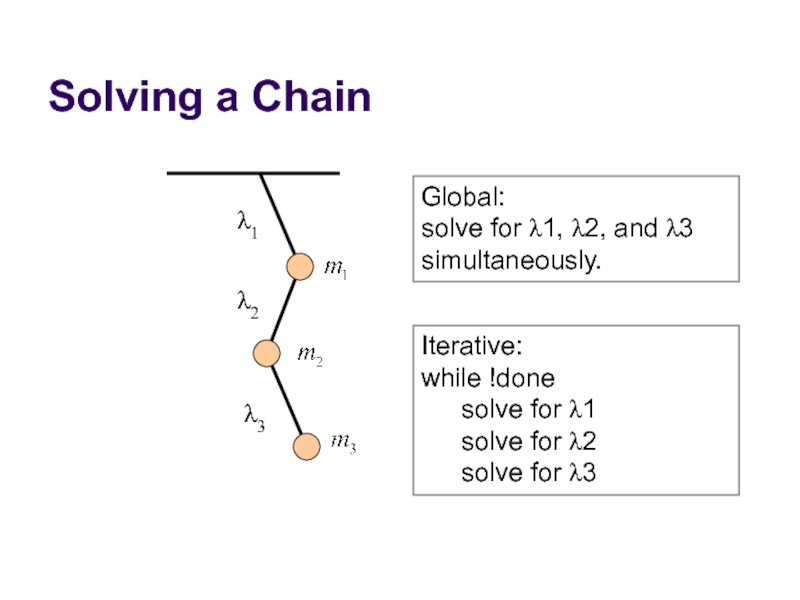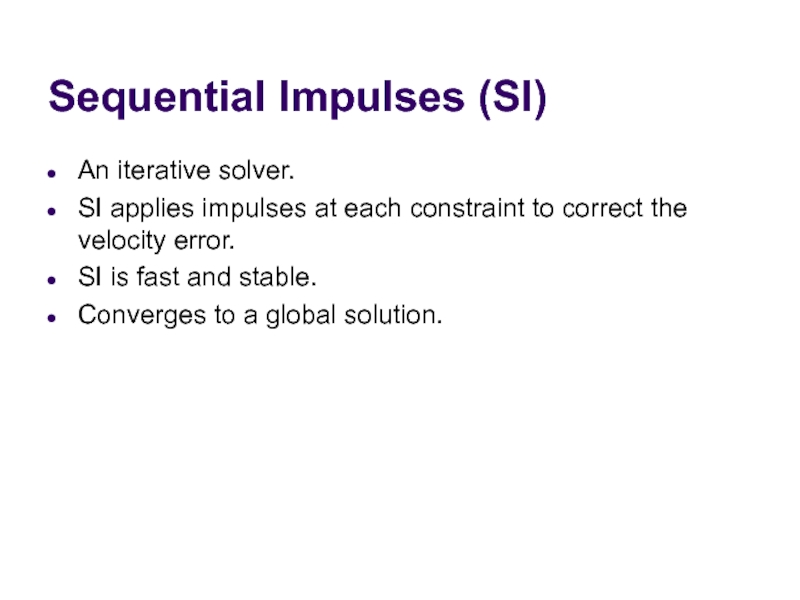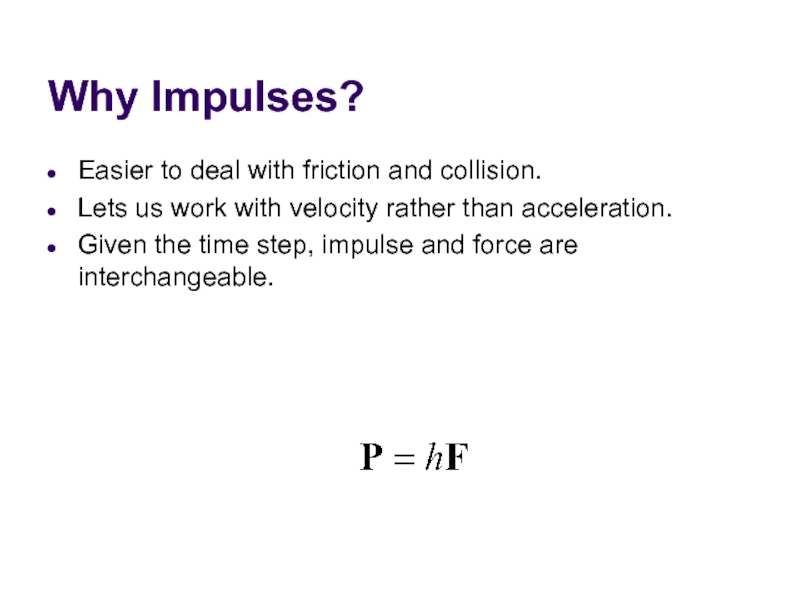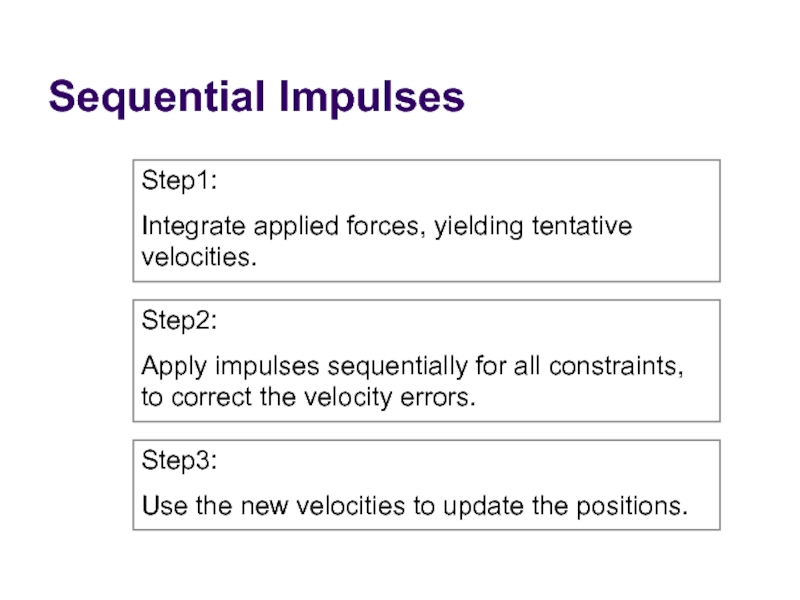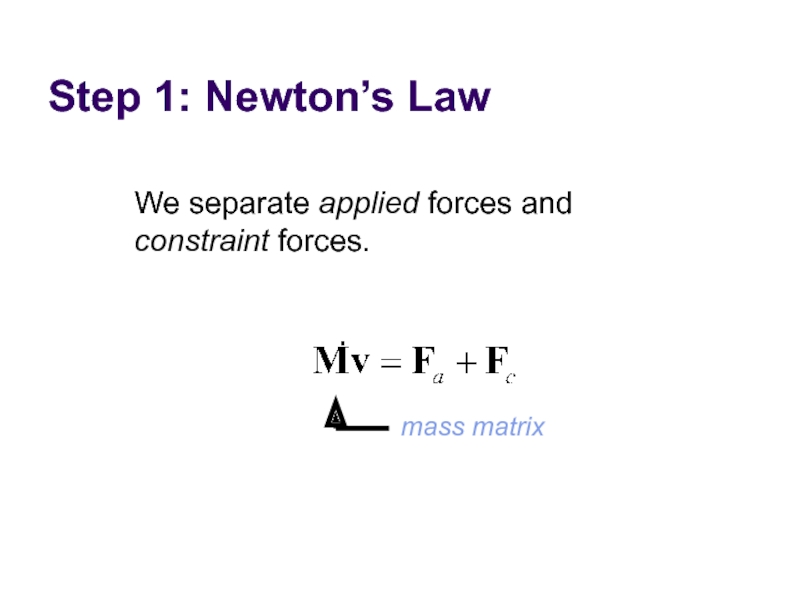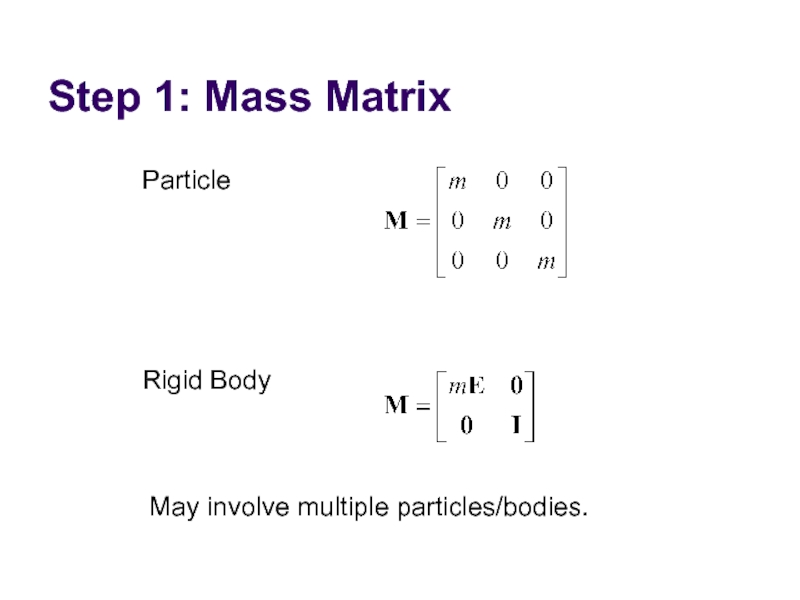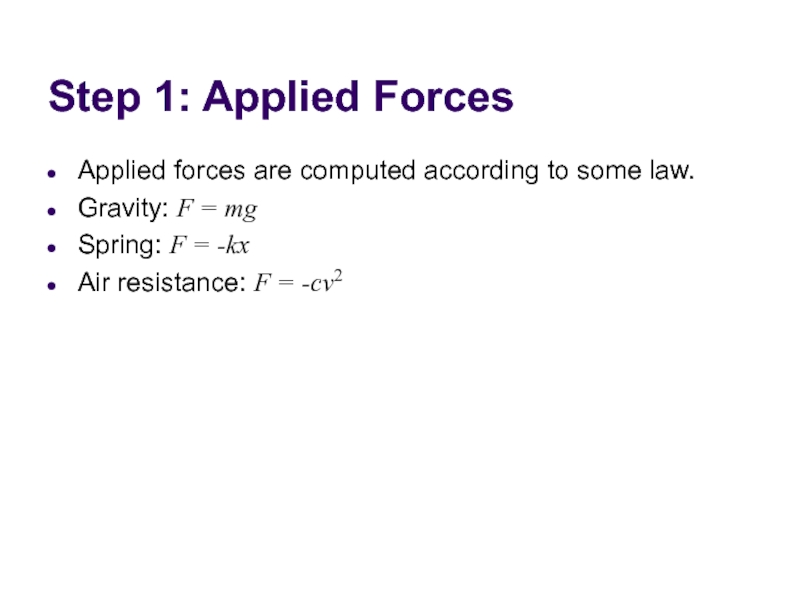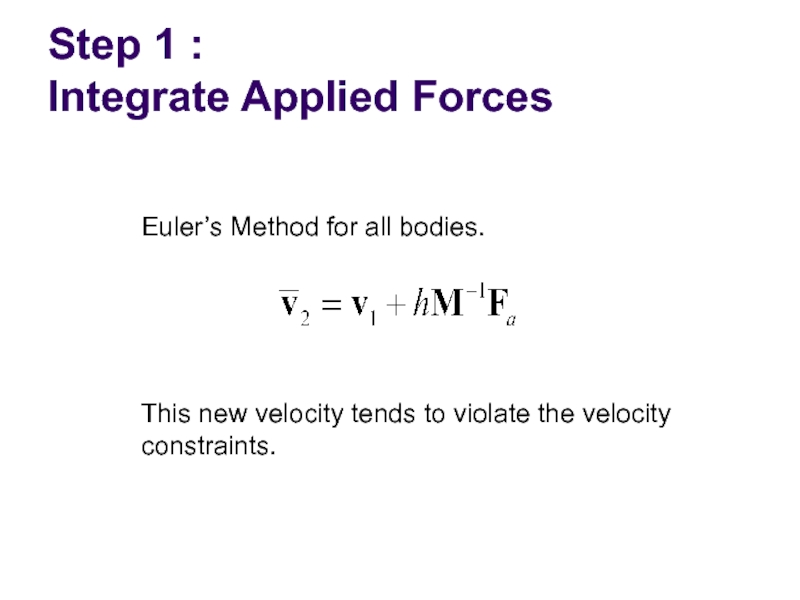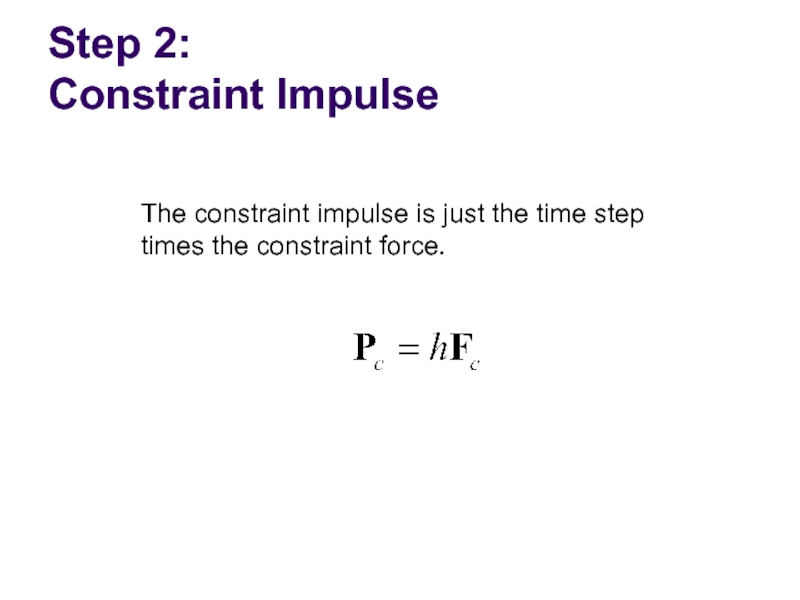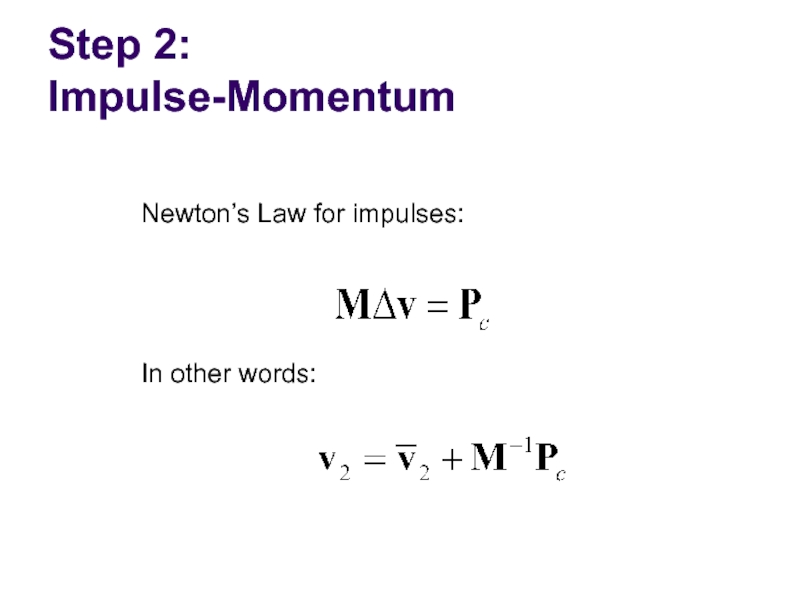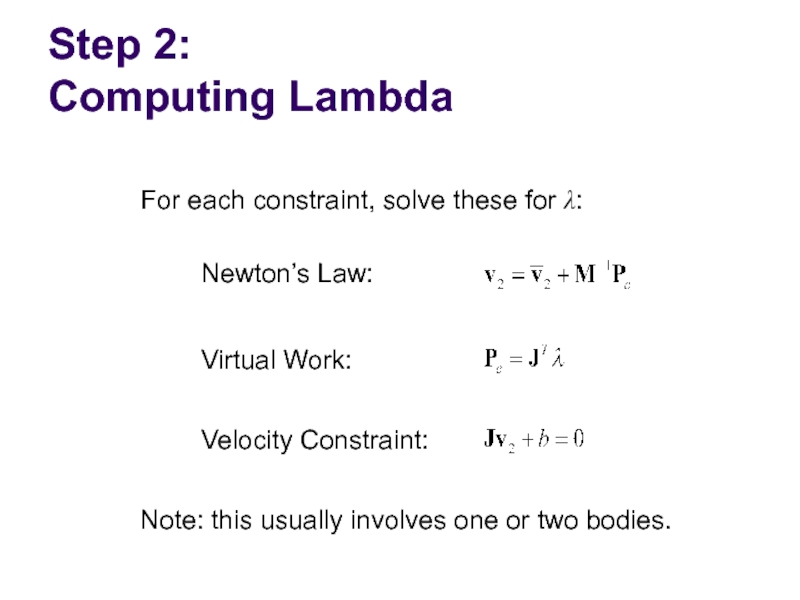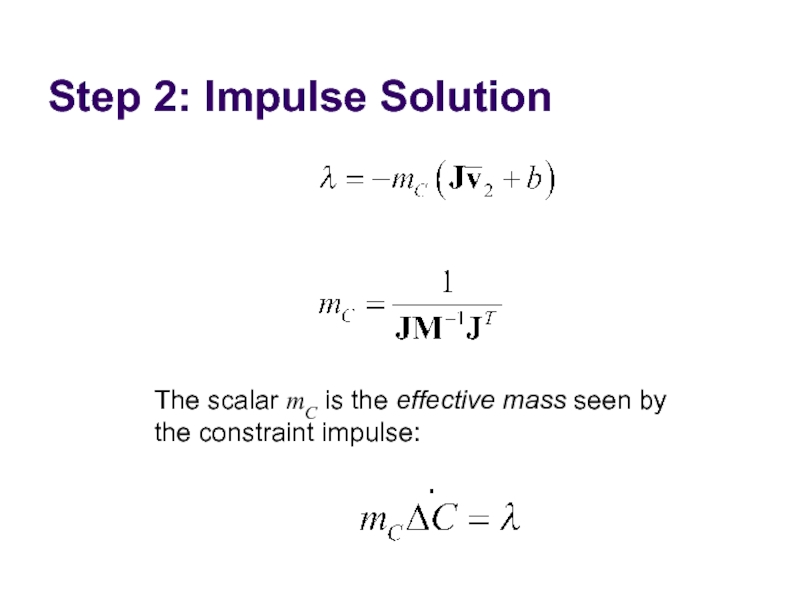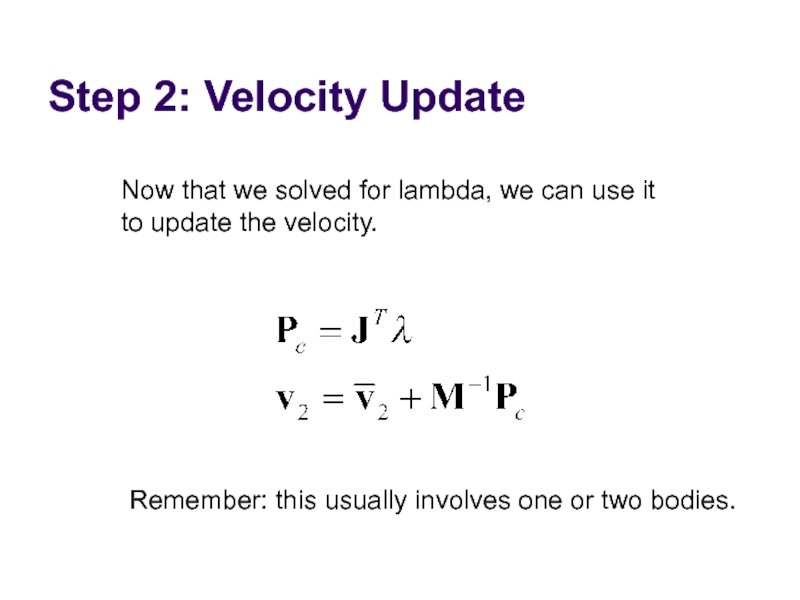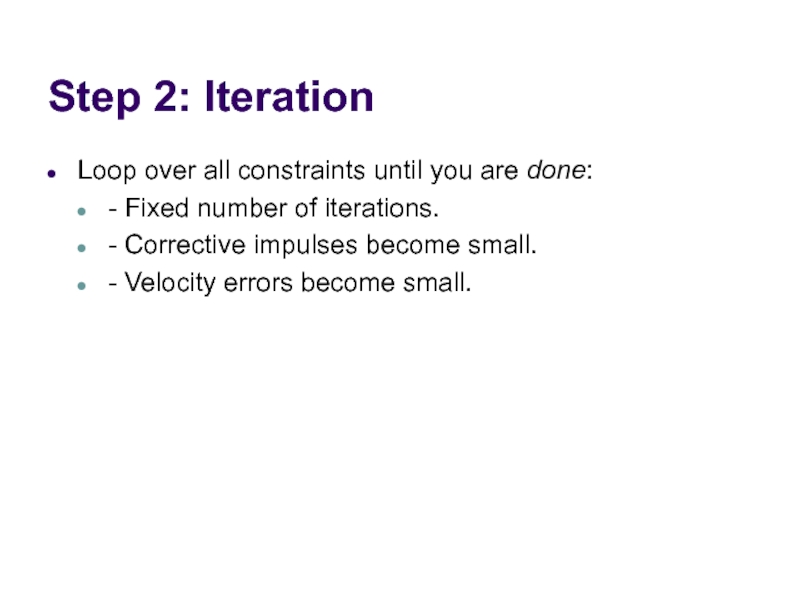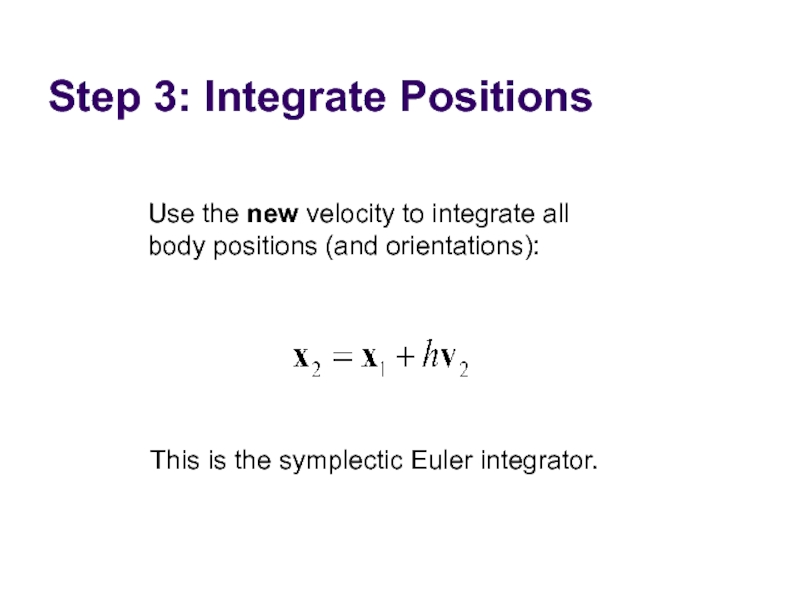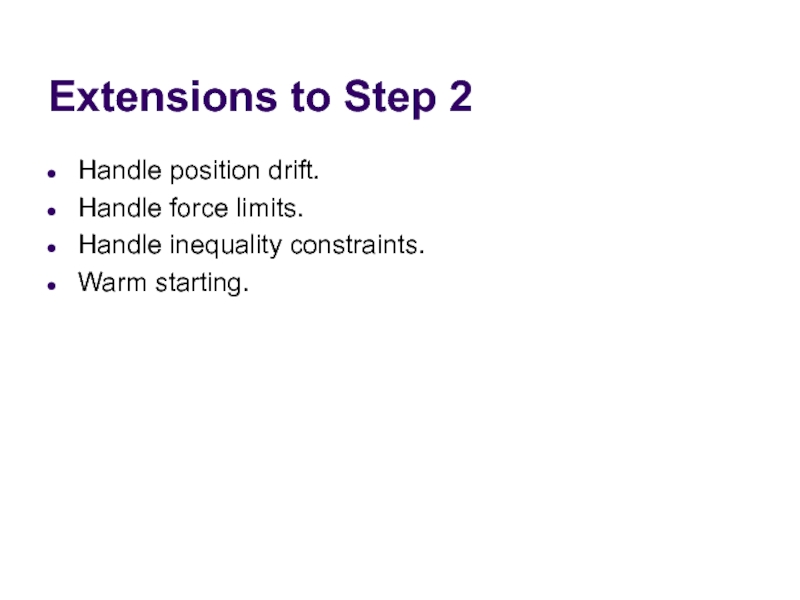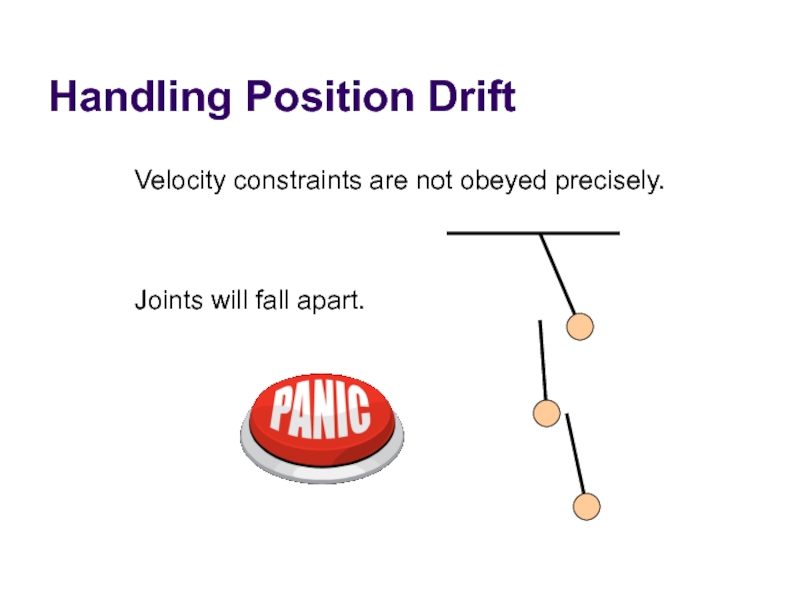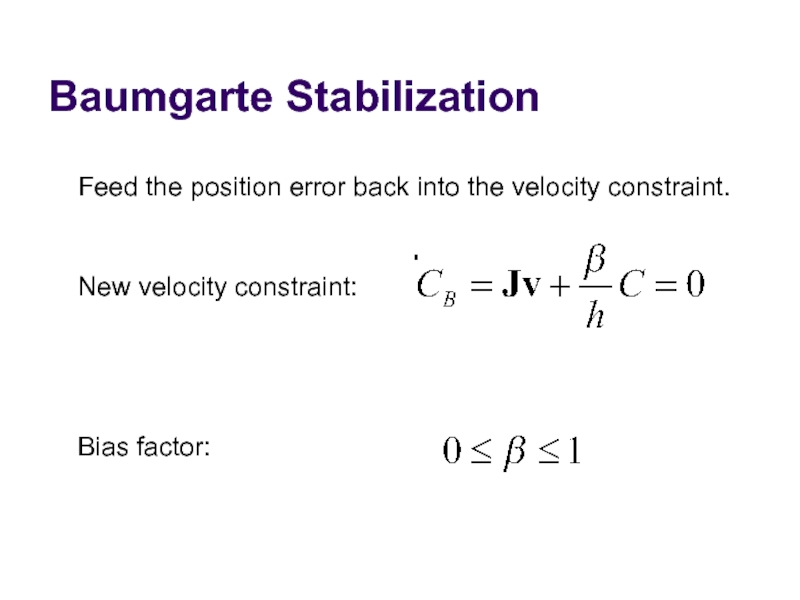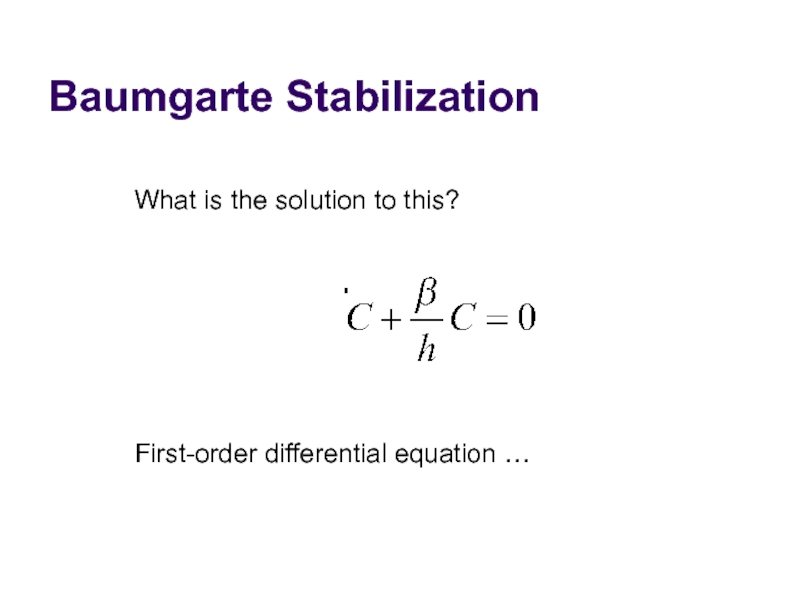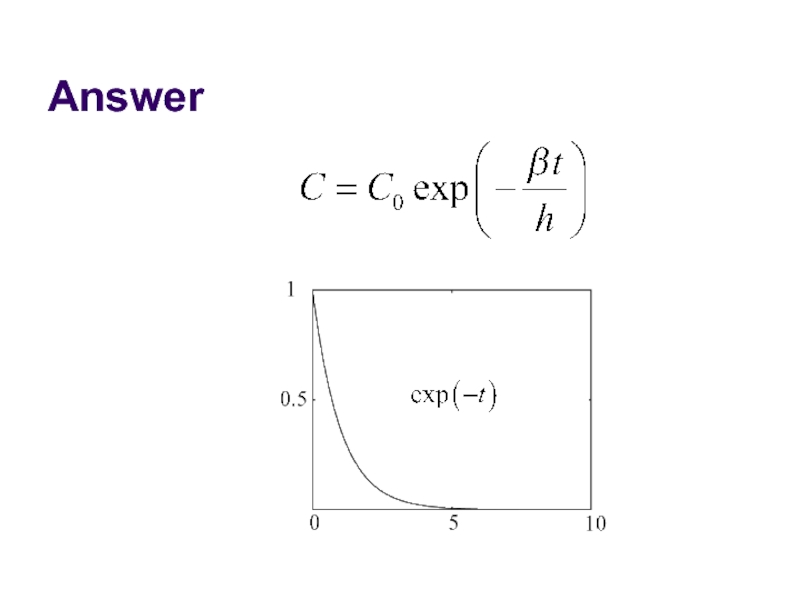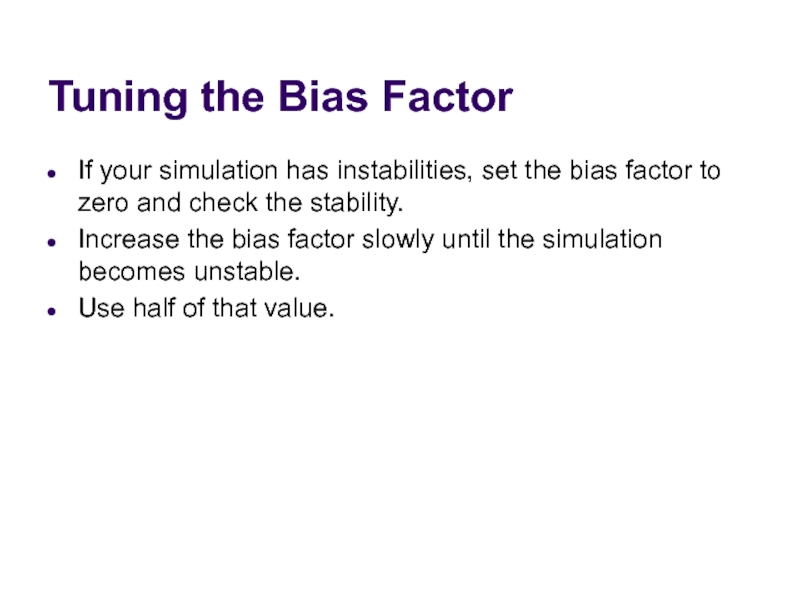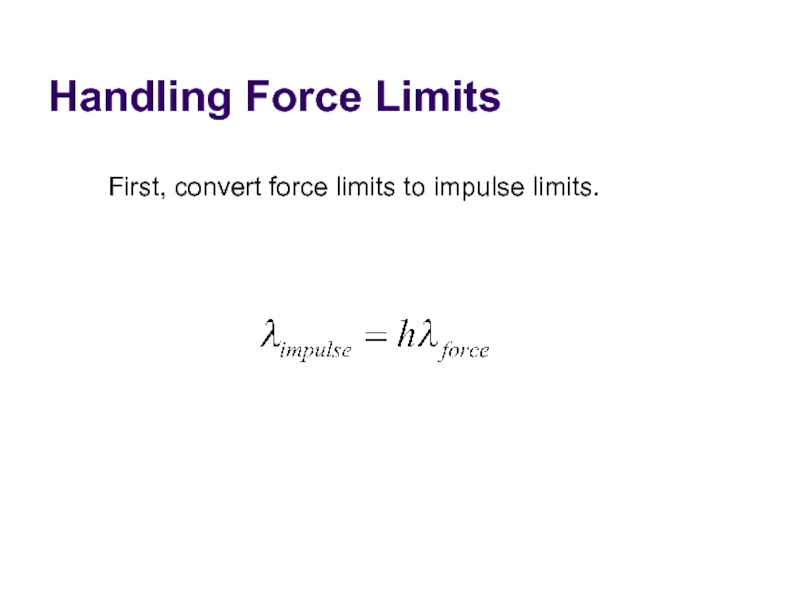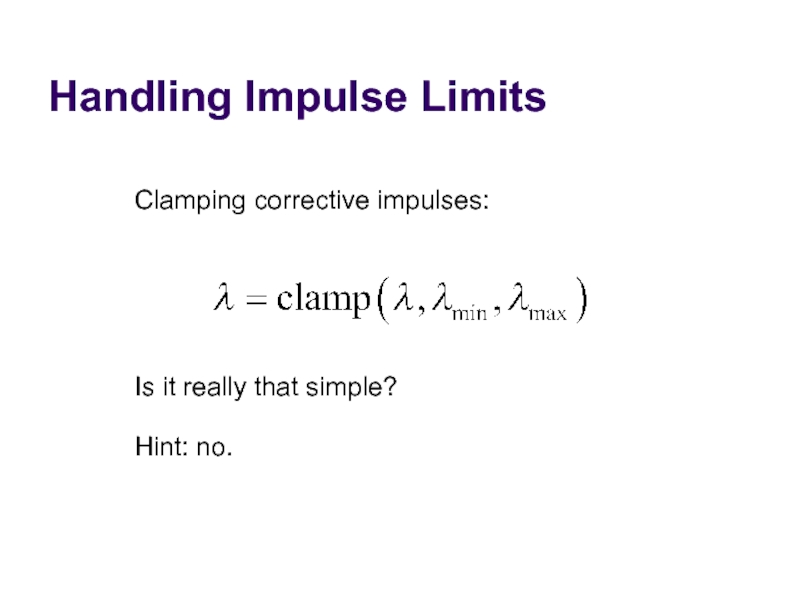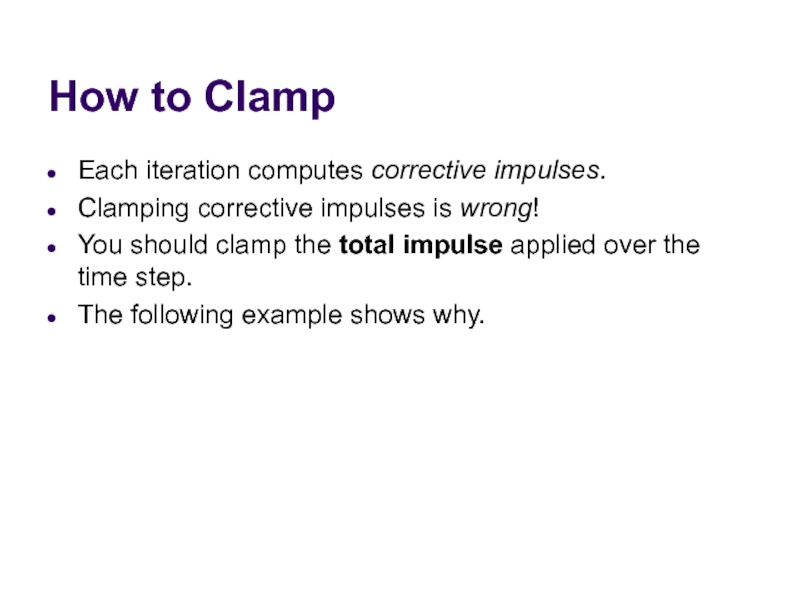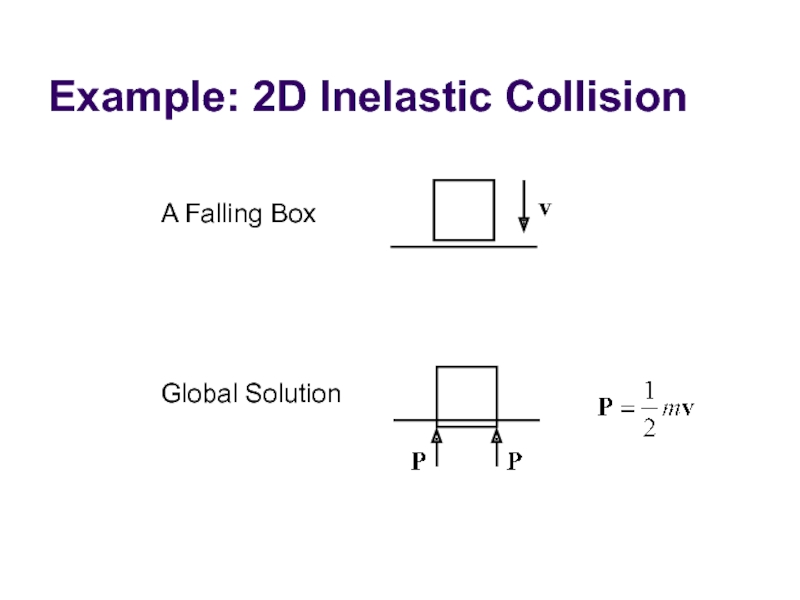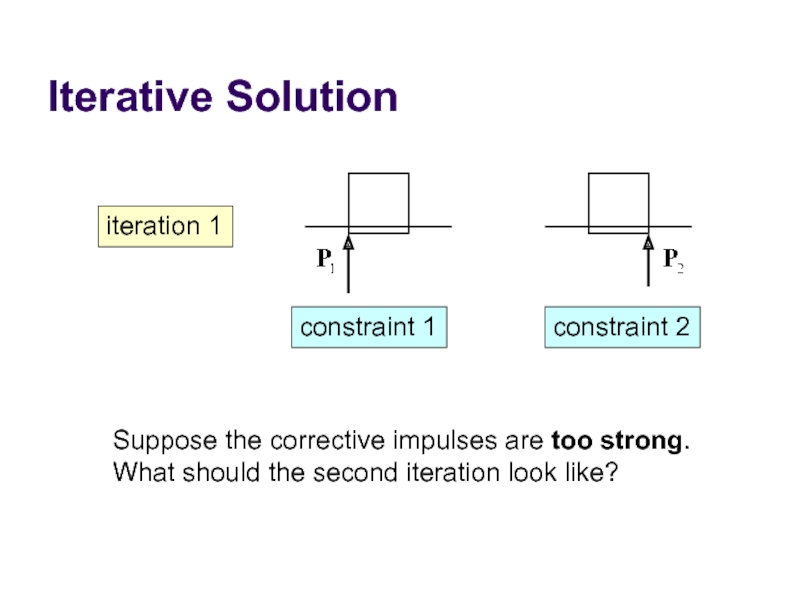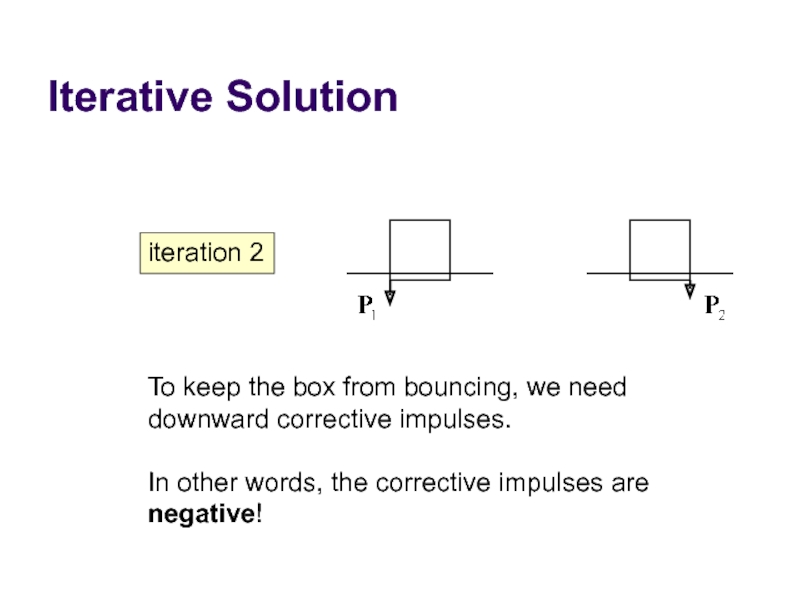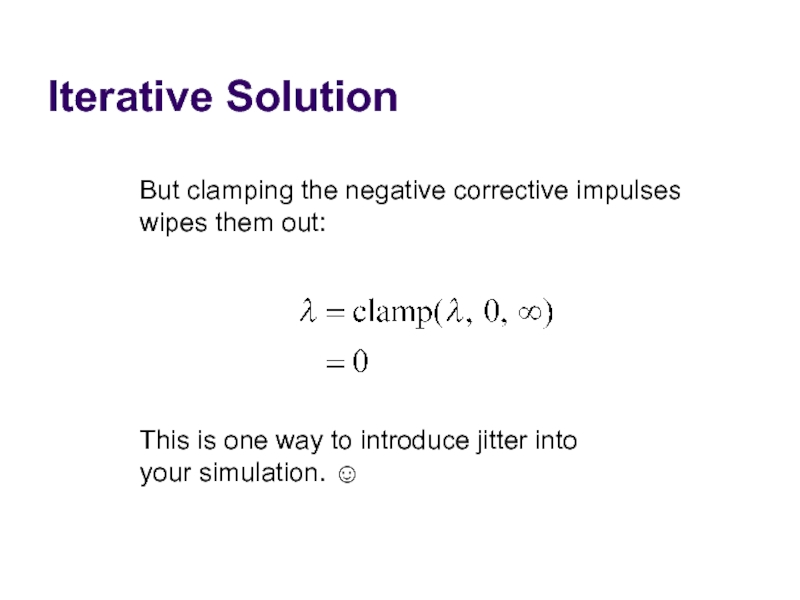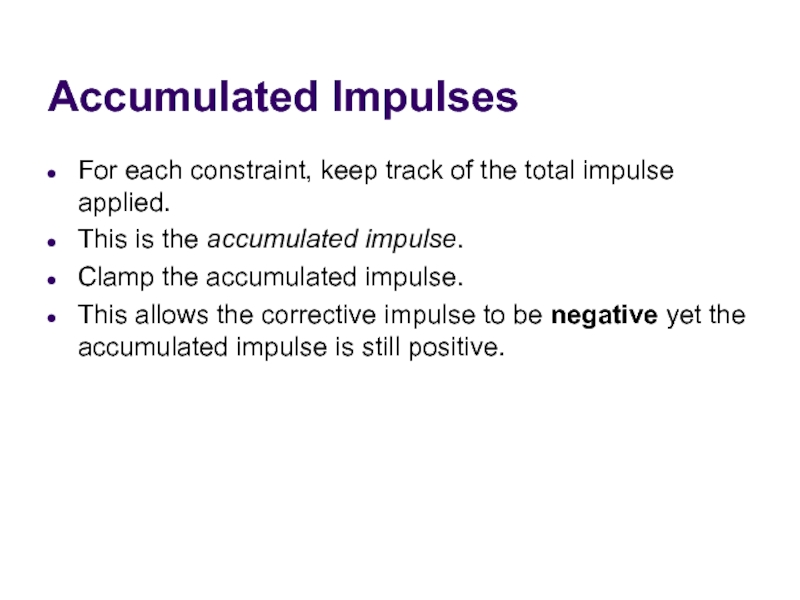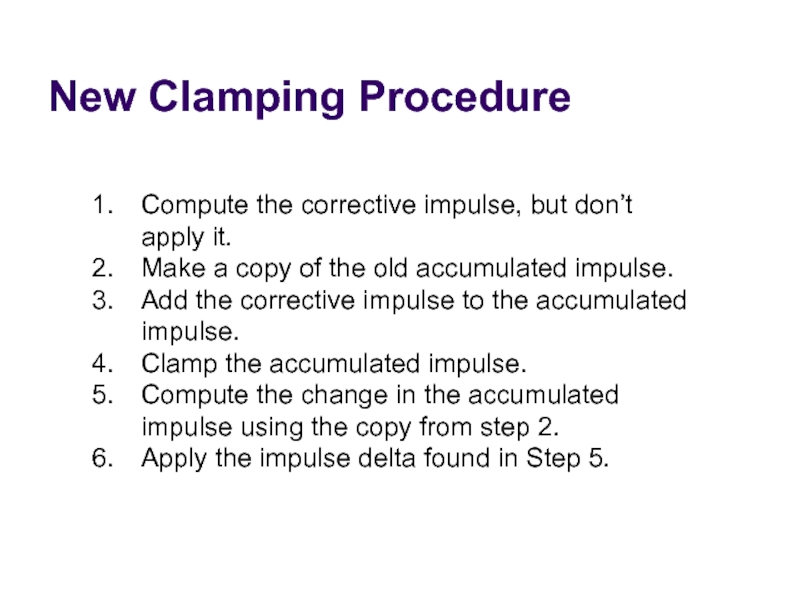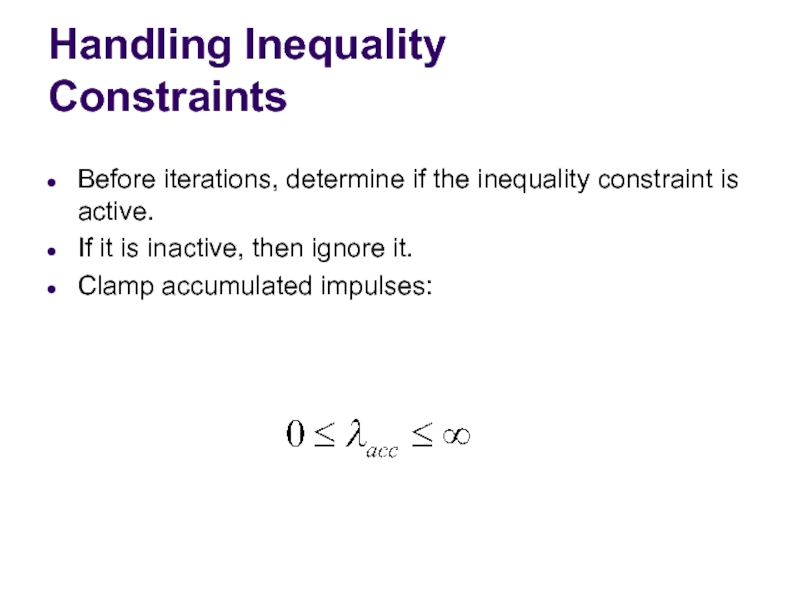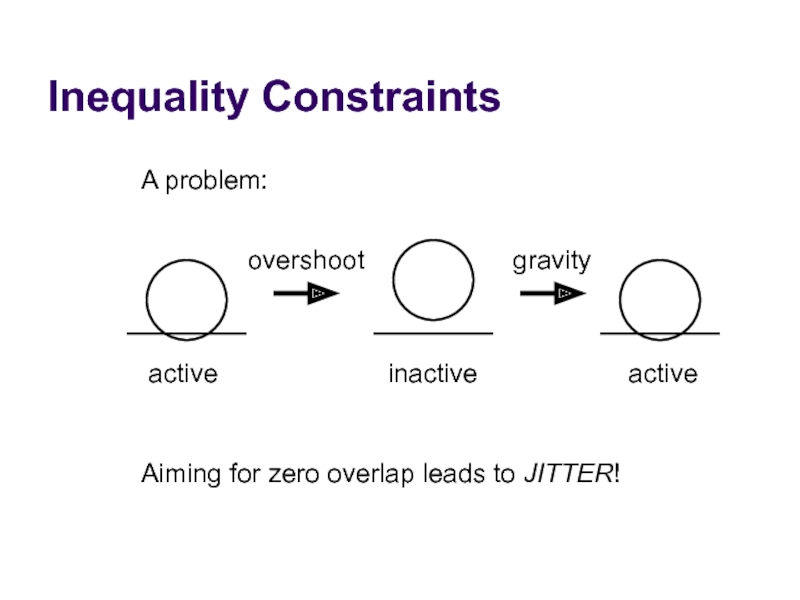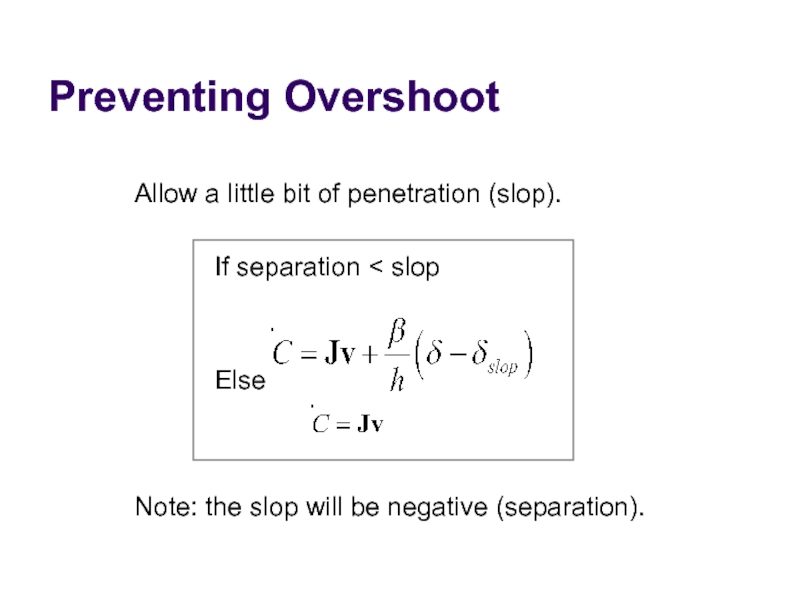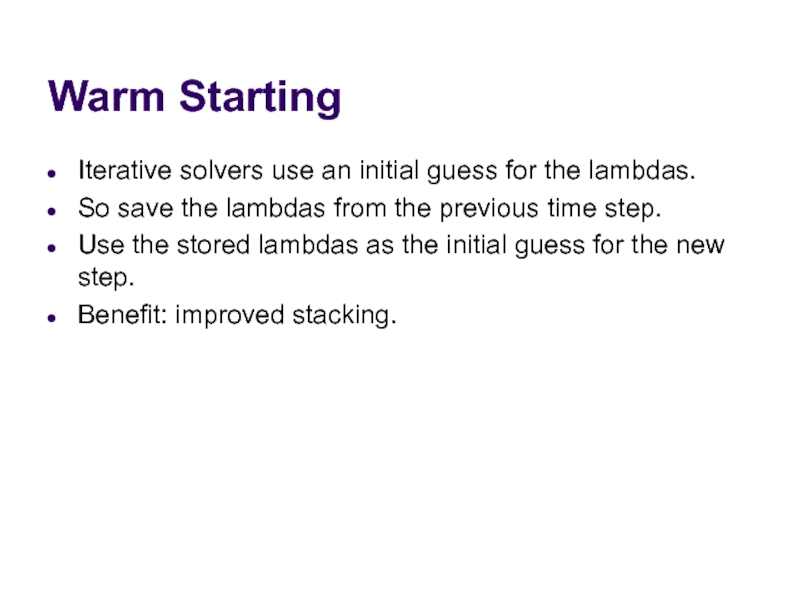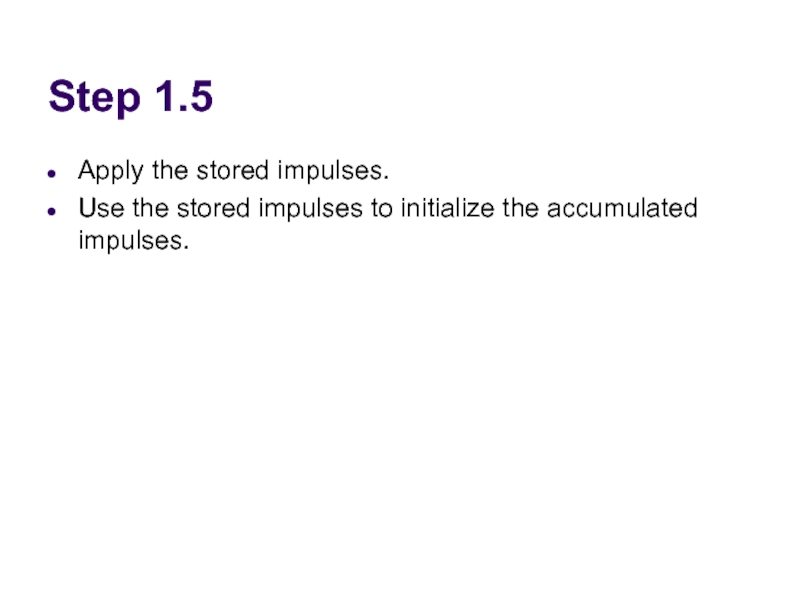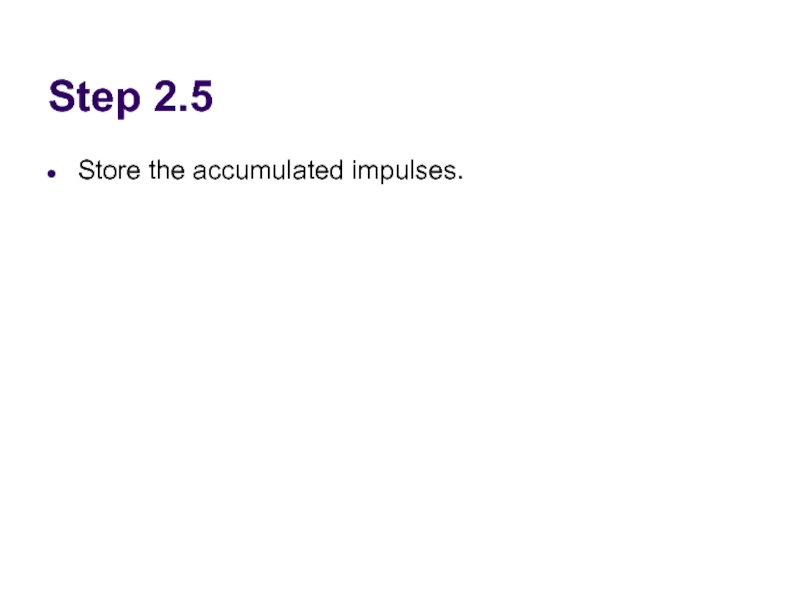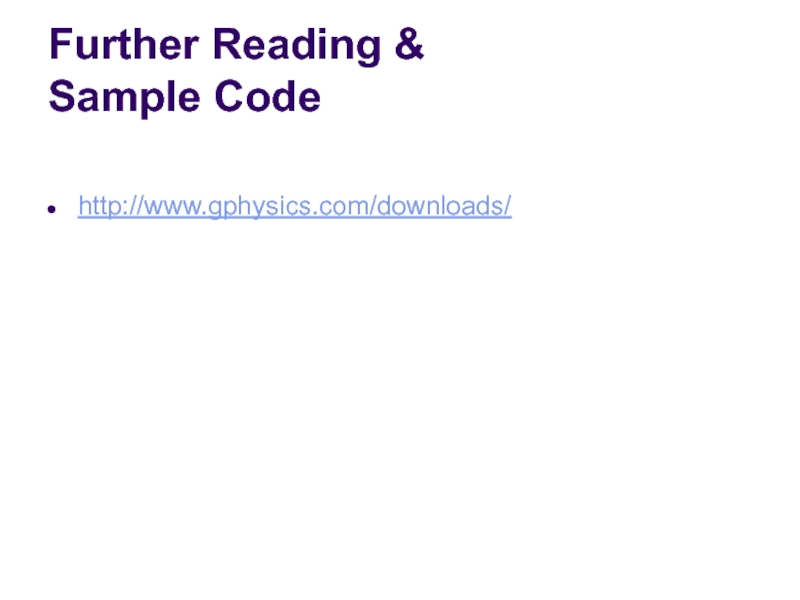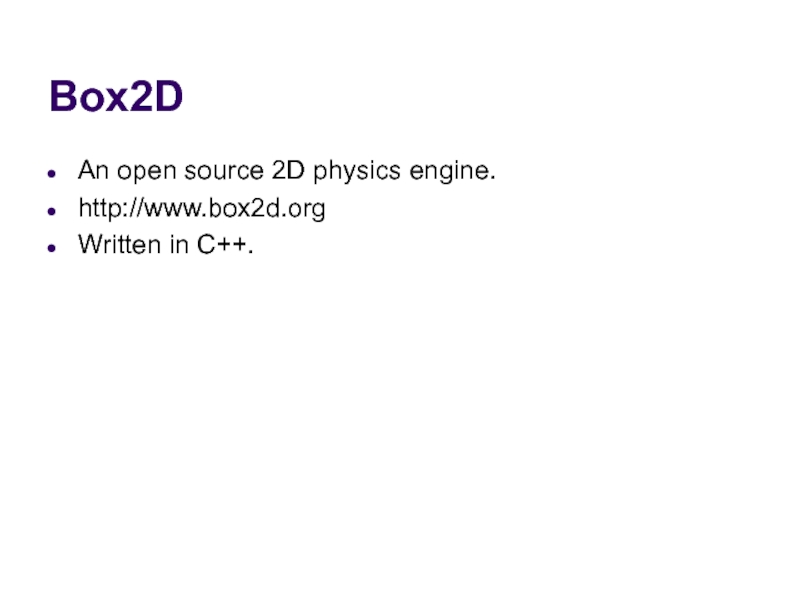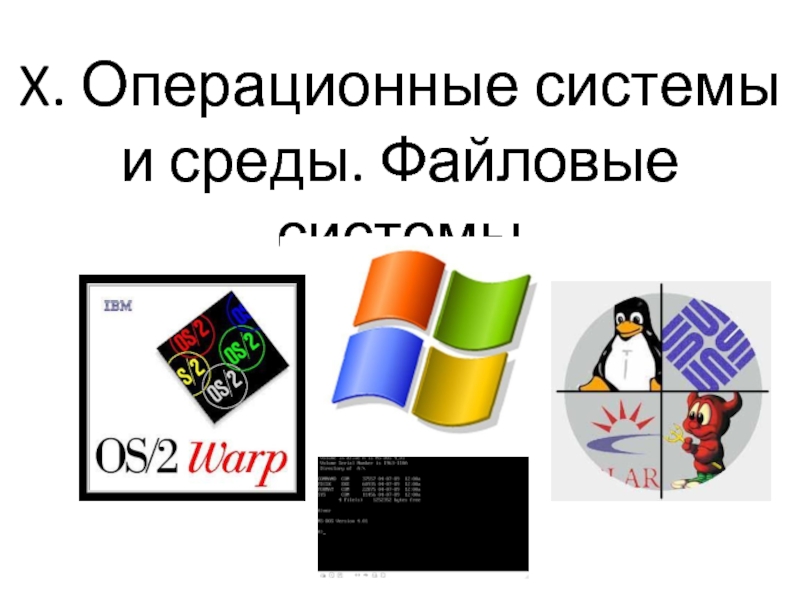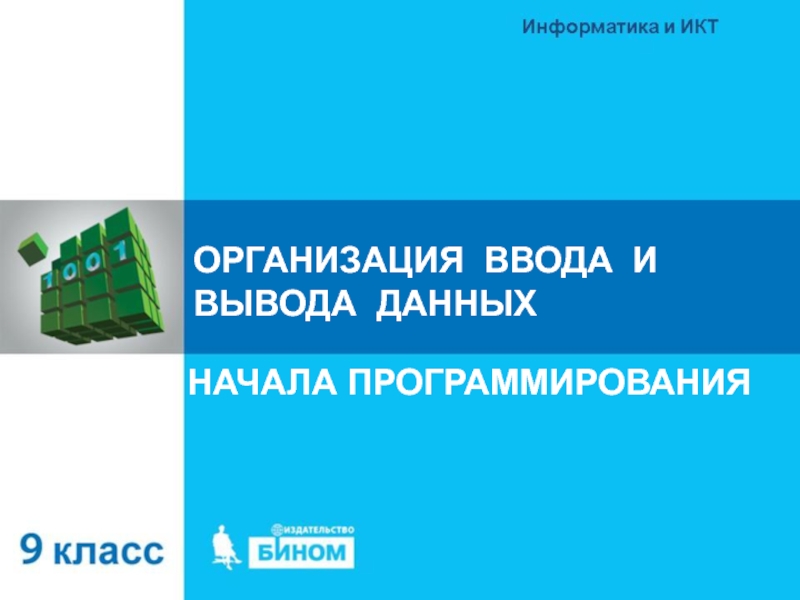- Главная
- Разное
- Дизайн
- Бизнес и предпринимательство
- Аналитика
- Образование
- Развлечения
- Красота и здоровье
- Финансы
- Государство
- Путешествия
- Спорт
- Недвижимость
- Армия
- Графика
- Культурология
- Еда и кулинария
- Лингвистика
- Английский язык
- Астрономия
- Алгебра
- Биология
- География
- Детские презентации
- Информатика
- История
- Литература
- Маркетинг
- Математика
- Медицина
- Менеджмент
- Музыка
- МХК
- Немецкий язык
- ОБЖ
- Обществознание
- Окружающий мир
- Педагогика
- Русский язык
- Технология
- Физика
- Философия
- Химия
- Шаблоны, картинки для презентаций
- Экология
- Экономика
- Юриспруденция
Modeling and Solving Constraints. Basic Idea презентация
Содержание
- 1. Modeling and Solving Constraints. Basic Idea
- 2. Basic Idea Constraints are used to simulate
- 3. Overview Constraint Formulas Jacobians, Lagrange Multipliers Modeling
- 4. Constraint Types Contact and Friction
- 5. Constraint Types Ragdolls
- 6. Constraint Types Particles and Cloth
- 7. Show Me the Demo!
- 8. Bead on a 2D Rigid Wire
- 9. How does it move? The normal vector is perpendicular to the velocity.
- 10. Enter The Calculus Position Constraint: Velocity Constraint:
- 11. Velocity Constraint Velocity constraints define the allowed
- 12. The Jacobian Due to the chain rule
- 13. The Jacobian The Jacobian is perpendicular to the velocity.
- 14. Constraint Force Assume the wire is frictionless.
- 15. Lagrange Multiplier Intuitively the constraint force Fc
- 16. Lagrange Multiplier The Lagrange Multiplier (lambda) is
- 17. Jacobian as a CoordinateTransform Similar to a
- 18. Velocity Transform v Cartesian Space Velocity Constraint Space Velocity
- 19. Force Transform Constraint Space Force Cartesian Space Force
- 20. Refresher: Work and Power Work = Force
- 21. Principle of Virtual Work Principle: constraint forces
- 22. Constraint Quantities Position Constraint Velocity Constraint Jacobian Lagrange Multiplier
- 23. Why all the Painful Abstraction? We want
- 24. Addendum: Modeling Time Dependence Some constraints, like
- 25. Example: Distance Constraint y x L Position: Velocity: Jacobian: Velocity Bias: particle
- 26. Gory Details
- 27. Computing the Jacobian At first, it is
- 28. A Recipe for J Use geometry to
- 29. Constraint Potpourri Joints Motors Contact Restitution Friction
- 30. Joint: Distance Constraint y x v
- 31. Motors A motor is a constraint with
- 32. Velocity Only Motors Example Usage: A
- 33. Inequality Constraints So far we’ve looked at
- 34. Inequality Constraints The corresponding velocity constraint: If Else skip constraint enforce:
- 35. Inequality Constraints Force Limits: Inequality constraints don’t suck.
- 36. Contact Constraint Non-penetration. Restitution: bounce Friction: sliding, sticking, and rolling
- 37. Non-Penetration Constraint body 2 body 1 (separation)
- 38. Non-Penetration Constraint J Handy Identities
- 39. Restitution Relative normal velocity Adding bounce as a velocity bias Velocity Reflection
- 40. Friction Constraint Friction is like a velocity-only
- 41. Friction Constraint The friction force is limited
- 42. Constraints Solvers We have a bunch of
- 43. Constraint Solver Types Global Solvers (slow) Iterative Solvers (fast)
- 44. Solving a Chain λ1
- 45. Sequential Impulses (SI) An iterative solver. SI
- 46. Why Impulses? Easier to deal with friction
- 47. Sequential Impulses Step1: Integrate applied forces, yielding
- 48. Step 1: Newton’s Law We separate applied forces and constraint forces. mass matrix
- 49. Step 1: Mass Matrix Particle Rigid Body May involve multiple particles/bodies.
- 50. Step 1: Applied Forces Applied forces are
- 51. Step 1 : Integrate Applied Forces Euler’s
- 52. Step 2: Constraint Impulse The constraint impulse
- 53. Step 2: Impulse-Momentum Newton’s Law for impulses: In other words:
- 54. Step 2: Computing Lambda For each constraint,
- 55. Step 2: Impulse Solution The scalar mC
- 56. Step 2: Velocity Update Now that we
- 57. Step 2: Iteration Loop over all constraints
- 58. Step 3: Integrate Positions Use the new
- 59. Extensions to Step 2 Handle position drift. Handle force limits. Handle inequality constraints. Warm starting.
- 60. Handling Position Drift Velocity constraints are not
- 61. Baumgarte Stabilization Feed the position error back
- 62. Baumgarte Stabilization What is the solution to this? First-order differential equation …
- 63. Answer
- 64. Tuning the Bias Factor If your simulation
- 65. Handling Force Limits First, convert force limits to impulse limits.
- 66. Handling Impulse Limits Clamping corrective impulses: Is it really that simple? Hint: no.
- 67. How to Clamp Each iteration computes corrective
- 68. Example: 2D Inelastic Collision v A Falling Box Global Solution
- 69. Iterative Solution iteration 1 constraint
- 70. Iterative Solution iteration 2 To
- 71. Iterative Solution But clamping the negative corrective
- 72. Accumulated Impulses For each constraint, keep track
- 73. New Clamping Procedure Compute the corrective impulse,
- 74. Handling Inequality Constraints Before iterations, determine if
- 75. Inequality Constraints A problem:
- 76. Preventing Overshoot Allow a little bit of
- 77. Warm Starting Iterative solvers use an initial
- 78. Step 1.5 Apply the stored impulses. Use the stored impulses to initialize the accumulated impulses.
- 79. Step 2.5 Store the accumulated impulses.
- 80. Further Reading & Sample Code http://www.gphysics.com/downloads/
- 81. Box2D An open source 2D physics engine. http://www.box2d.org Written in C++.
Слайд 2Basic Idea
Constraints are used to simulate joints, contact, and collision.
We need
Constraint solvers do this by calculating impulse or forces, and applying them to the constrained bodies.
Слайд 3Overview
Constraint Formulas
Jacobians, Lagrange Multipliers
Modeling Constraints
Joints, Motors, Contact
Building a Constraint Solver
Sequential Impulses
Слайд 10Enter The Calculus
Position Constraint:
Velocity Constraint:
If C is zero, then its time
Слайд 11Velocity Constraint
Velocity constraints define the allowed motion.
Next we’ll show that velocity
Слайд 12The Jacobian
Due to the chain rule the velocity constraint has a
J is a row vector called the Jacobian.
J depends on position.
The velocity constraint is linear.
Слайд 14Constraint Force
Assume the wire is frictionless.
What is the force between the
Слайд 15Lagrange Multiplier
Intuitively the constraint force Fc is parallel to the normal
Direction known.
Magnitude unknown.
implies
Слайд 16Lagrange Multiplier
The Lagrange Multiplier (lambda) is the constraint force signed magnitude.
We
Слайд 17Jacobian as a CoordinateTransform
Similar to a rotation matrix.
Except it is missing
So it projects some dimensions to zero.
The transpose is missing some columns, so some dimensions get added.
Слайд 20Refresher: Work and Power
Work = Force times Distance
Work has units of
Power = Force times Velocity (Watts)
Слайд 21Principle of Virtual Work
Principle: constraint forces do no work.
Proof (compute the
The power is zero, so the constraint does no work.
We can ensure this by using:
Слайд 23Why all the Painful Abstraction?
We want to put all constraints into
This allows us to efficiently try different solution techniques.
Слайд 24Addendum:
Modeling Time Dependence
Some constraints, like motors, have prescribed motion.
This is represented
Position:
Velocity:
velocity bias
Слайд 27Computing the Jacobian
At first, it is not easy to compute the
It gets easier with practice.
If you can define a position constraint, you can find its Jacobian.
Here’s how …
Слайд 28A Recipe for J
Use geometry to write C.
Differentiate C with respect
Isolate v.
Identify J and b by inspection.
Слайд 31Motors
A motor is a constraint with limited force (torque).
Example
A Wheel
Note: this
Слайд 32Velocity Only Motors
Example
Usage: A wheel that spins at a constant rate.
We
Слайд 33Inequality Constraints
So far we’ve looked at equality constraints (because they are
Inequality constraints are needed for contact and joint limits.
We put all inequality position constraints into this form:
Слайд 36Contact Constraint
Non-penetration.
Restitution: bounce
Friction: sliding, sticking, and rolling
Слайд 41Friction Constraint
The friction force is limited by the normal force.
Coulomb’s Law:
In
3D is a bit more complicated. See the references.
Слайд 42Constraints Solvers
We have a bunch of constraints.
We have unknown constraint forces.
We
There are many ways different ways to compute constraint forces.
Слайд 44Solving a Chain
λ1
λ2
λ3
Global:
solve for λ1, λ2, and λ3 simultaneously.
Iterative:
while !done
solve for
solve for λ2
solve for λ3
Слайд 45Sequential Impulses (SI)
An iterative solver.
SI applies impulses at each constraint to
SI is fast and stable.
Converges to a global solution.
Слайд 46Why Impulses?
Easier to deal with friction and collision.
Lets us work with
Given the time step, impulse and force are interchangeable.
Слайд 47Sequential Impulses
Step1:
Integrate applied forces, yielding tentative velocities.
Step2:
Apply impulses sequentially for all
Step3:
Use the new velocities to update the positions.
Слайд 50Step 1: Applied Forces
Applied forces are computed according to some law.
Gravity:
Spring: F = -kx
Air resistance: F = -cv2
Слайд 51Step 1 :
Integrate Applied Forces
Euler’s Method for all bodies.
This new velocity
Слайд 52Step 2:
Constraint Impulse
The constraint impulse is just the time step times
Слайд 54Step 2:
Computing Lambda
For each constraint, solve these for λ:
Newton’s Law:
Virtual Work:
Velocity
Note: this usually involves one or two bodies.
Слайд 56Step 2: Velocity Update
Now that we solved for lambda, we can
to update the velocity.
Remember: this usually involves one or two bodies.
Слайд 57Step 2: Iteration
Loop over all constraints until you are done:
- Fixed
- Corrective impulses become small.
- Velocity errors become small.
Слайд 58Step 3: Integrate Positions
Use the new velocity to integrate all body
This is the symplectic Euler integrator.
Слайд 59Extensions to Step 2
Handle position drift.
Handle force limits.
Handle inequality constraints.
Warm starting.
Слайд 60Handling Position Drift
Velocity constraints are not obeyed precisely.
Joints will fall apart.
Слайд 61Baumgarte Stabilization
Feed the position error back into the velocity constraint.
New velocity
Bias factor:
Слайд 64Tuning the Bias Factor
If your simulation has instabilities, set the bias
Increase the bias factor slowly until the simulation becomes unstable.
Use half of that value.
Слайд 67How to Clamp
Each iteration computes corrective impulses.
Clamping corrective impulses is wrong!
You
The following example shows why.
Слайд 69Iterative Solution
iteration 1
constraint 1
constraint 2
Suppose the corrective impulses are too strong.
What
Слайд 70Iterative Solution
iteration 2
To keep the box from bouncing, we need
downward corrective
In other words, the corrective impulses are
negative!
Слайд 71Iterative Solution
But clamping the negative corrective impulses
wipes them out:
This is one
your simulation. ☺
Слайд 72Accumulated Impulses
For each constraint, keep track of the total impulse applied.
This
Clamp the accumulated impulse.
This allows the corrective impulse to be negative yet the accumulated impulse is still positive.
Слайд 73New Clamping Procedure
Compute the corrective impulse, but don’t apply it.
Make a
Add the corrective impulse to the accumulated impulse.
Clamp the accumulated impulse.
Compute the change in the accumulated impulse using the copy from step 2.
Apply the impulse delta found in Step 5.
Слайд 74Handling Inequality Constraints
Before iterations, determine if the inequality constraint is active.
If
Clamp accumulated impulses:
Слайд 75Inequality Constraints
A problem:
overshoot
active
inactive
active
gravity
Aiming for zero overlap leads to JITTER!
Слайд 76Preventing Overshoot
Allow a little bit of penetration (slop).
If separation < slop
Else
Note:
Слайд 77Warm Starting
Iterative solvers use an initial guess for the lambdas.
So save
Use the stored lambdas as the initial guess for the new step.
Benefit: improved stacking.
